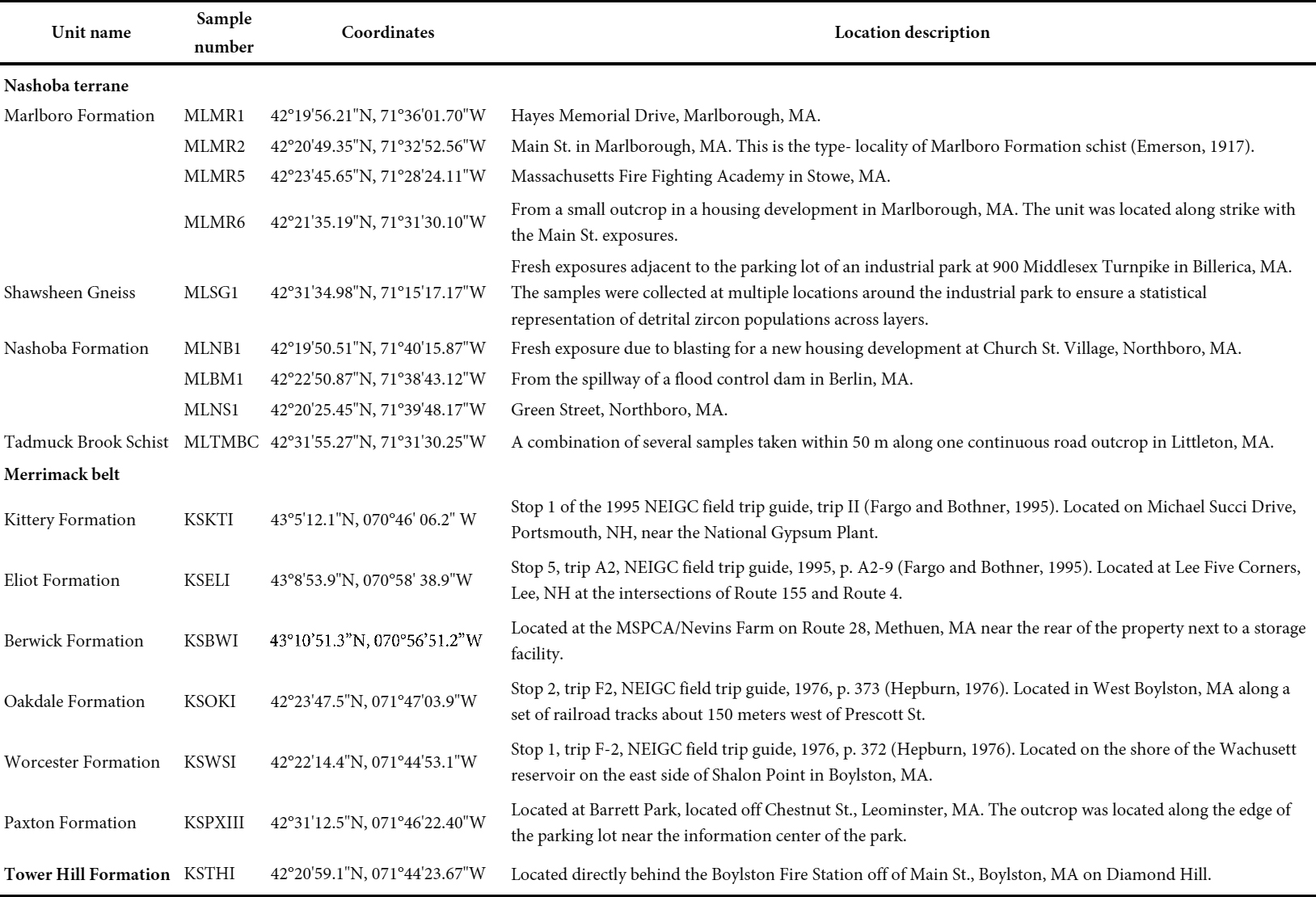Article
Detrital zircon ages and the origins of the Nashoba terrane and Merrimack belt in southeastern New England, USA
doi:10.4138/atlgeol.2021.016
Abstract
The fault-bounded Nashoba–Putnam terrane, a metamorphosed early Paleozoic, Ganderian arc/back-arc complex in SE New England, lies between rocks of Avalonian affinity to the southeast and middle Paleozoic sedimentary rocks, interpreted as cover on Ganderian basement, in the Merrimack belt to the northwest. U–Pb detrital zircon laser ablation inductively coupled plasma mass spectrometry analysis were conduced on six samples from the Nashoba terrane in Massachusetts and seven samples associated with the Merrimack belt in Massachusetts and SE New Hampshire to investigate their depositional ages and provenance. Samples from the Nashoba terrane yielded major age populations between ~560 and ~540 Ma, consistent with input from local sources formed during the Ediacaran–Cambrian Penobscot orogenic cycle and its basement rocks. Youngest detrital zircons in the terrane, however, are as young as the Early to Middle Ordovician. Six formations from the Merrimack belt were deposited between ~435 and 420 Ma based on youngest zircon age populations and crosscutting plutons, and yielded large ~470–443 Ma age populations. Three of these formations show only Gondwanan provenance. Three others have a mixed Gondwanan-Laurentian signal, which is known to be typical for younger and/or more westerly sedimentary rocks and may indicate that they are the youngest deposits in the Merrimack belt (late Silurian to early Devonian) and/or have been deposited in the equivalent of the more westerly Central Maine basin. Detrital zircon age populations from the Tower Hill Formation, along the faulted contact between the Merrimack belt and Nashoba terrane, are different from either of these tectonic domains and may indicate that the boundary is complex.
Résumé
Le terrane limité par des failles de Nashoba-Putnam, un complexe d’arc/arrière-arc métamorphisé gandérien du Paléozoïque précoce dans le sud-est de la Nouvelle-Angleterre, se trouve entre des roches ayant une affinité avalonienne au sud-est et des roches sédimentaires du Paléozoïque moyen, interprétées comme une couverture du socle gandérien, dans la ceinture de Merrimack au nord-ouest. Six échantillons provenant du terrane de Nashoba au Massachusetts et sept échantillons associés à la ceinture de Merrimack au Massachusetts et dans le sud-est du New Hampshire ont fait l’objet d’une analyse par spectrométrie de masse avec plasma à couplage inductif et par ablation par laser de datation U–Pb sur zircon détritique aux fins de l’examen de leurs âges sédimentaires et de leur provenance. Les échantillons provenant du terrane de Nashoba ont révélé des populations principalement âgées entre environ 560 et 540 Ma, ce qui correspond à la contribution des sources locales apparues durant le cycle orogénique édiacarien-cambrien de Penobscot et aux roches de son socle. Les zircons détritiques les plus récents dans le terrane remontent cependant seulement à l’Ordovicien précoce à moyen. Six formations de la ceinture de Merrimack se sont déposées à peu près entre 435 et 420 Ma selon les populations des âges les plus récents sur zircon et les plutons transversaux, et elles ont présenté de vastes populations âgées d’environ 470 à 443 Ma. Trois de ces formations témoignent uniquement d’une provenance gondwanienne. Trois autres évoquent de façon mixte le Gondwanien et le Laurentien, ce qui est reconnu comme un trait typique des roches sédimentaires plus récentes ou plus à l’ouest et qui pourrait révéler qu’il s’agit de dépôts plus récents dans la ceinture de Merrimack (du Silurien tardif au Dévonien précoce) ou qui se seraient mis en place dans l’unité équivalente du bassin plus occidental du centre du Maine. Les populations d’un âge sur zircon détritique de la Formation de Tower Hill le long de la zone de contact faillé entre la ceinture de Merrimack et le terrane de Nashoba diffèrent de l’un et l’autre de ces domaines tectoniques et pourraient indiquer que leur limite est complexe.
[Traduit par la redaction]
INTRODUCTION
1 Two Neoproterozoic to early Paleozoic Gondwananderived terranes form the eastern portion of southeastern New England: Avalonia to the southeast and the Nashoba– Putnam terrane of Ganderian affinity to its northwest. These are followed westward by a thick succession of Silurian– Devonian cover rocks in the Merrimack belt (Fig. 1). In order to develop a comprehensive overview of the sedimentary and tectonic history of Ganderia in southeastern New England, analyses of detrital zircon from representative metasedimentary rocks in both the Nashoba terrane and Merrimack belt were carried out by U–Pb laser ablation inductively coupled plasma mass spectrometry (LA-ICPMS) to determine their maximum depositional ages, provenance and potential correlations in the northern Appalachians. Six samples from the Nashoba terrane in Massachusetts and six from the Merrimack belt in Massachusetts and southeastern New Hampshire were analyzed. One additional sample was taken from along the faulted boundary between the Merrimack belt and the Nashoba terrane.
 Display large image of Figure 1
Display large image of Figure 1
Geological background
Nashoba terrane
2 The Nashoba terrane in eastern Massachusetts (Fig. 1) is an early Paleozoic arc/back-arc complex that, based on Sm/ Nd isotope compositions and model ages, developed on an older crustal basement (e.g., Goldsmith 1991a; Hepburn et al. 1995; Kay et al. 2017; Walsh et al. 2021). It has been interpreted as the trailing edge of Ganderia in SE New England (e.g., Hibbard et al. 2006; van Staal et al. 2009; Walsh et al. 2011b, 2015, 2021; Kay et al. 2017). The Nashoba terrane consists of highly metamorphosed and multiply deformed early Paleozoic volcanic and volcanogenic sedimentary rocks that are intruded by abundant middle Paleozoic dioritic and granitic plutons (e.g., Wones and Goldsmith 1991; Zartman and Marvin 1991; Hepburn et al. 1995). It is separated from the Avalonian rocks to the southeast by the Burlington mylonite zone, which was later overprinted by the more brittle Bloody Bluff fault zone (Castle et al. 1976; Zen et al. 1983; Skehan et al. 1998; Kohut and Hepburn 2004), and from the Merrimack belt to the northwest by the Clinton-Newbury fault zone (Figs. 1, 2; Skehan 1968; Castle et al. 1976; Zen et al. 1983; Goldsmith 1991b). The stratified units generally dip moderately to steeply northwest (Bell and Alvord 1976; Goldsmith 1991a). In the southeast, the terrane consists largely of mafic metavolcanic and metasedimentary rocks of the Marlboro Formation, while to the northwest predominantly volcanogenic metasedimentary rocks of the Nashoba Formation dominate (Bell and Alvord 1976; Goldsmith 1991a; Hepburn et al. 1995). Other major units include a schistose unit (Tadmuck Brook Schist), an orthogneiss (Fish Brook Gneiss) and a paragneiss (Shawsheen Gneiss) (Fig. 2; Bell and Alvord 1976; Zen et al. 1983; Goldsmith 1991a; Hepburn et al. 1995). The metavolcanic and metasedimentary units in the southeast are interpreted to have been part of an arc or formed in a near-arc basin, while those in the northwest have been interpreted to represent largely contemporaneous to somewhat younger sedimentary deposits with minor volcanic input in a back-arc basin developed farther from an arc (e.g., Goldsmith 1991a; Hepburn et al. 1995; Kay et al. 2017).
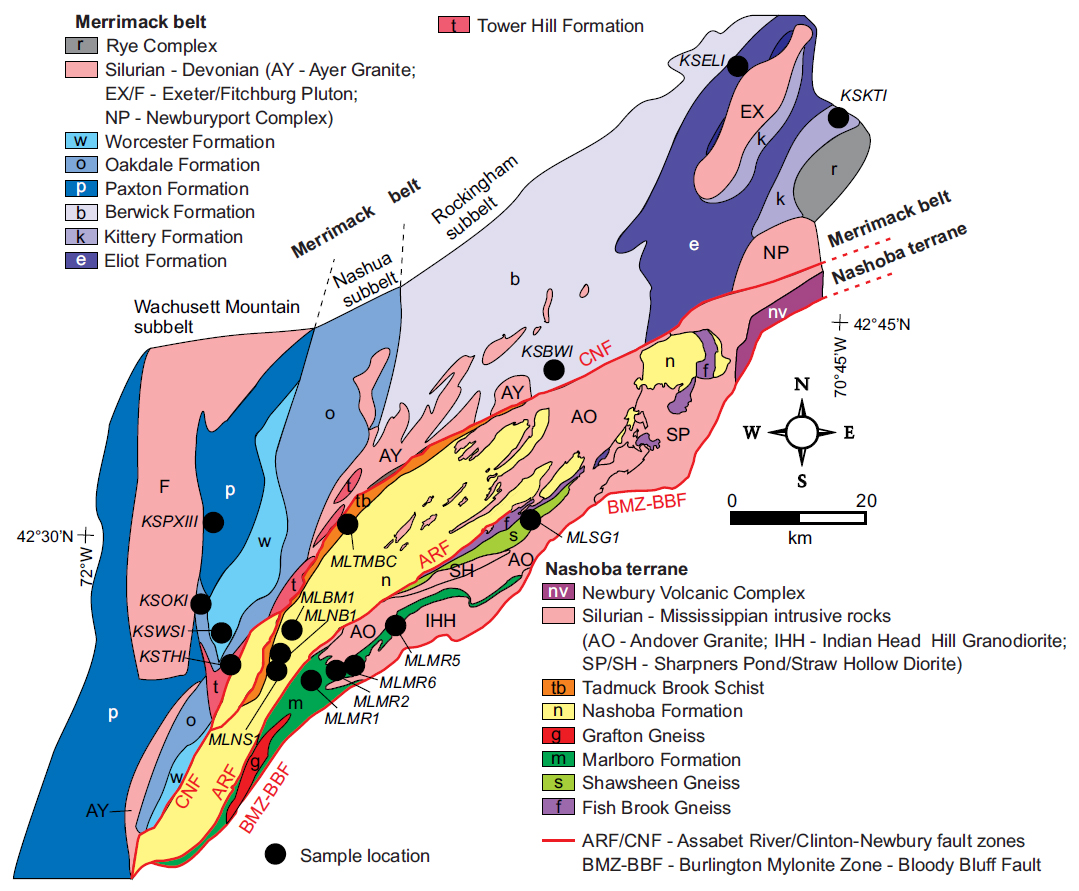 Display large image of Figure 2
Display large image of Figure 2
3 The terrane is intruded by abundant Silurian to Carboniferous granitic and dioritic plutons. Some of these plutons have been dated using various methods of U–Pb zircon geochronology. These include the 430 ± 5 Ma Sharpner’s Pond Diorite (Zartman and Naylor 1984), two phases of the Andover Granite, which are 419 ± 0.5 Ma (Dabrowski 2013; Dabrowski et al. 2013) and 412 ± 2 Ma (Hepburn et al. 1995), the 420.5 ± 0.5 Ma Sudbury granite (Dabrowski 2013; Dabrowski et al. 2013), the 385 ± 10 Ma Straw Hollow diorite (Acaster and Bickford 1999) and the 349 ± 4 Ma Indian Head Hill Granite (Hepburn et al. 1995).
4 Previous age determinations on rocks associated with the stratified units in the Nashoba terrane are limited. They include a ~540 Ma mafic boudin in the Quinebaug Formation (a unit in the Putnam terrane to the south in Connecticut correlated with the Marlboro Formation), a 515 ± 4 Ma date on the Grafton Gneiss that cross-cuts part of the Marlboro Formation, and a 500.6 ± 4.2 Ma date on a feldspathic granofels in the Marlboro Formation structurally above the Grafton Gneiss (U–Pb zircon SHRIMP, Walsh et al. 2009, 2011a, b, 2021). The granofels was derived from a proximal volcanic source and its age is interpreted as the approximate age of deposition (Walsh et al. 2021). In addition to the ~540–500 Ma volcanic rocks of the Marlboro Formation and the Grafton Gneiss, the Fish Brook orthogneiss (Fig. 2) has also been dated as Cambrian (499 +6/-3 Ma, U–Pb zircon ID-TIMS, Hepburn et al. 1995).
5 Deformation and metamorphism in the Nashoba terrane are primarily a result of the late Silurian–Devonian Acadian orogeny that resulted from accretion of Avalonia and its subsequent westward convergence (e.g., Hepburn et al. 1995; van Staal et al. 2009, 2020; Kuiper et al. 2014; Walsh et al. 2015, 2021; Severson 2020). Post-Acadian zircon and monazite in the Nashoba terrane have been interpreted to be a result of the late Devonian Neoacadian and/or Pennsylvanian–Permian Alleghanian orogenic events and/or hydrothermal fluids (Wintsch et al. 2007; Stroud et al. 2009; Loan 2011; Buchanan et al. 2017; Walsh et al. 2021).
Late Ordovician to Early Devonian cover successions
6 Late Ordovician to Early Devonian calcareous and pelitic turbiditic rocks form extensive cover successions on older Ganderian rocks throughout the northern Appalachians from southern New England to Newfoundland (e.g., Williams 1978; Tucker et al. 2001; Tremblay and Pinet 2005; Hibbard et al. 2006). In New England, these sedimentary rocks show increasing Laurentian affinity to the west where they define the Connecticut Valley-Gaspé trough (Fig. 1; e.g., Hibbard et al. 2006; Rankin et al. 2007). To the east (Fig. 1), two extensive depocenters of these rocks, the Fredericton trough and Central Maine basin, are defined by their location with respect to inliers of Cambrian–Ordovician basement rocks (e.g., Reusch and van Staal 2012; Ludman et al. 2018). However, the terminology that has been applied to these rocks across New England is complex and varied as it includes both structural and sedimentary terms (i.e., belt, synclinorium, basin, trough) as well as various stratigraphic names and correlations. Figure 3 summarizes the principal stratigraphic names by location for the relevant Late Ordovician to Early Devonian cover rocks in eastern and central New England and southern New Brunswick. Below we explain, from north to south, some of the definitions of basins used by others, and the rationale behind them. We then summarize the definitions used in this contribution, which are largely based on this previous work.
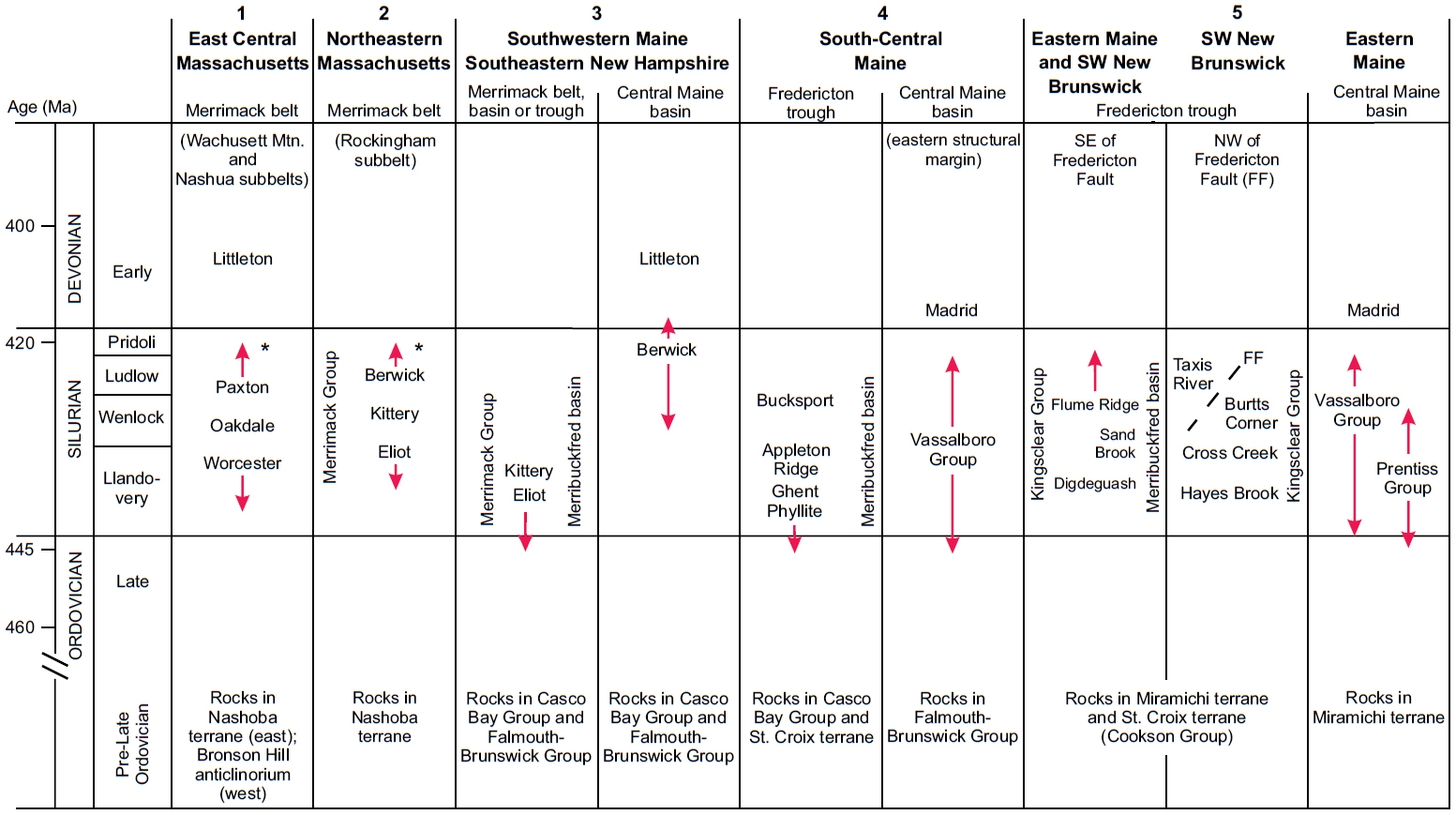 Display large image of Figure 3
Display large image of Figure 3
7 In eastern Maine and New Brunswick, the Fredericton trough lies between the Late Ordovician and older rocks of the St. Croix terrane to the SE and the Miramichi terrane to the NW (Fig. 1; e.g., Reusch and van Staal 2012; Ludman et al. 2017, 2018; Dokken et al. 2018). The broader Central Maine basin, including the along-strike Aroostock- Matapedia basin to the north, formed between the Miramichi terrane to the SE and older rocks of the Bronson Hill arc and related inliers to the NW (Fig. 1; Osberg et al. 1985; Tucker et al. 2001; Fyffe et al. 2009, 2011; Reusch and van Staal 2012; Bradley and O’Sullivan 2017; Ludman et al. 2017, 2018). Both the Fredericton trough and Central Maine basin contain late Ordovician (?) and Silurian sedimentary rocks. Deposition ended in the Fredericton trough by the late Silurian as it was deformed prior to intrusion by the 421.9 ± 2.4 Ma Pocomooshine gabbro-diorite (West et al. 1992; Ludman et al. 2018), while deposition continued into the Devonian in the Central Maine basin (Osberg 1988; Bradley et al. 2000; Tucker et al. 2001; Bradley and O’Sullivan 2017; Ludman et al. 2018). In south-central Maine and coastal southern Maine the Fredericton trough includes the Late Ordovician (?) and Silurian Ghent, Appleton Ridge and Bucksport formations (Figs. 1, 3; Hussey 1988; Berry and Osberg 1989; Hussey et al. 2010; West and Condit 2016; Cartwright et al. 2019) that lie southeast of Miramichi terrane-correlative Ordovician and older rocks in the Falmouth-Brunswick Group and Casco Bay Group (West et al. 2004, 2006; Hussey et al. 2010; Reusch and van Staal 2012; West and Hussey 2016, Hussey and West 2018).
8 In southwestern Maine and southeastern most New Hampshire, Late Ordovician and Silurian rocks that are approximately along strike, and can be correlated with those of the Fredericton trough and eastern part of the Central Maine basin form the Merrimack basin or Merrimack trough (Lyons et al. 1997; Fig. 1) and were originally included in the Merrimack Group (Fig. 3; Eliot, Kittery and Berwick formations; e.g., Hitchcock 1877; Katz 1917; Billings 1956; Lyons et al. 1997; Fargo and Bothner 1995; Hussey et al. 2010; see Hussey et al. 2010 for details). Hussey et al. (2010), however, redefined the Merrimack Group in SW Maine and New Hampshire to include only sedimentary rocks interpreted as Late Ordovician–early Silurian (Eliot and Kittery formations) and correlated them with those in the Fredericton trough. They correlated sedimentary rocks interpreted to be late Silurian–Early Devonian (Berwick Formation) with the Central Maine basin. Hussey et al. (1999, 2010) suggested that their redefined Late Ordovician–early Silurian Merrimack Group, in addition to the Fredericton trough deposits, including the Bucksport and associated formations of south-central Maine, represent a potentially continuous single basin and named it the Merribuckfred basin (Fig. 3). However, it is now known that the Fredericton trough also includes late Silurian deposits (Dokken et al. 2018; Ludman et al. 2018). Therefore, the Merribuckfred basin now refers more to a location than an age range and may include multiple basins deposited through time. We will use Merribuckfred basin as a general term for the Late Ordovician–Silurian basins east of the Miramichi terrane and its equivalents to the south, to differentiate them from the Central Maine basin on the west. We will use Fredericton trough and Merrimack basin when referring to deposits in specific locations (Figs. 1, 3).
9 The Central Maine basin continues southwest from eastern Maine and New Brunswick into southeastern New Hampshire (Fig. 1; Osberg et al. 1985; Zen et al. 1983; Lyons et al. 1997; Tucker et al. 2001; Hibbard et al. 2006; Wintsch et al. 2007; Hussey et al. 2010; Reusch and van Staal 2012). However, Ordovician and older rocks of the Miramichi terrane, Casco Bay Group or Falmouth-Brunswick Group are not present south of southwestern Maine, making the boundary between rocks in the Central Maine and Merribuckfred basins difficult to distinguish. In SE New Hampshire, Dorais et al. (2012) and Reusch and van Staal (2012) interpret these basins to be separated by the Ganderian Neoproterozoic Massabesic Gneiss Complex (Fig. 1). However, Hussey et al. (2010, 2016) separate these basins east of the Massabesic Gneiss Complex along the Nonesuch River fault in southwestern Maine and its continuation, the Calef fault, in New Hampshire (Fig. 1).
Merrimack belt in Massachusetts and SE New Hampshire
10 In Massachusetts, there is no clearly identified boundary between rocks correlative with those in the Merribuckfred or Central Maine basins. Therefore, Zen et al. (1983) and Robinson and Goldsmith (1991) included all the late Ordovician (?), Silurian and early Devonian metasedimentary rocks between Ordovician and older rocks in the Nashoba terrane to the east and the Bronson Hill anticlinorium to the west in the Merrimack belt (Figs. 1, 2). However, on some maps, the Central Maine basin continues south into Massachusetts between the Merrimack belt and the Bronson Hill anticlinorium (e.g., Hibbard et al. 2006; Rankin et al. 2007; Wintsch et al. 2007, 2014; Reusch and van Staal 2012; Kopera and Walsh 2014, Walsh et al. 2021). Here, we will follow the usage of Zen et al. (1983) and Robinson and Goldsmith (1991) and use the inclusive term Merrimack belt to include the Worcester, Oakdale, Paxton, Eliot, Kittery and Berwick formations (Figs. 2, 3) in Massachusetts and SE New Hampshire, but recognize that the Merrimack belt likely includes rocks that can be correlated with those in both the Merribuckfred and Central Maine basins (Tucker et al. 2001; Wintsch et al. 2007; Hussey et al. 2010). The Tower Hill Formation occurs along the Clinton-Newbury fault zone on the east side of the Merrimack belt in east-central Massachusetts (Fig. 2; Zen et al. 1983; Robinson and Goldsmith 1991). However, its placement within the Merrimack belt has been debated (see Robinson and Goldsmith 1991) and it will be considered separately below.
11 The Merrimack belt, excluding the Tower Hill Formation, generally consists of a thick succession of metamorphosed calcareous and pelitic turbiditic units containing sandstone, siltstone, phyllite and impure quartzite (e.g., Grew 1973; Peck 1976; Robinson 1981; Zen et al. 1983; Robinson and Goldsmith 1991; Hussey and Bothner 1993; Lyons et al. 1997; Hussey et al. 2010). Because of (1) the lack of fossils, (2) the presence of thick successions of similar rock types in various areas, (3) a paucity of clear sedimentary structures to give facing directions, (4) varying degrees of metamorphism across and along strike, and (5) structural complexities due to several generations of folds, the internal stratigraphic order and along-strike correlations of units of the Merrimack belt has long been debated (e.g., Billings 1956, Robinson and Goldsmith 1991, Hussey et al. 2010). Robin-son and Goldsmith (1991) presented a thorough discussion of the stratigraphic arguments for rocks in the Merrimack belt in central Massachusetts and Hussey et al. (2010) for SE New Hampshire. These are not repeated or further discussed here.
12 The Merrimack belt in Massachusetts is divided into six stratigraphic-tectonic subbelts by Robinson and Goldsmith (1991). Our samples are from the eastern three: the Wachusett Mountain, Nashua and Rockingham subbelts (Fig. 2). The Rockingham subbelt continues into SE New Hampshire and contains the Eliot, Kittery and Berwick formations of the original Merrimack Group (Hitchcock 1877; Katz 1917; Billings 1956; Lyons et al. 1997; Fargo and Bothner 1995; Hussey et al. 2010). The Tower Hill Formation is within Robinson and Goldsmith’s (1991) Nashua subbelt, but occurs along the Clinton-Newbury fault zone adjacent to the contact with the Nashoba terrane and will be discussed separately.
13 The metamorphic grade of the sedimentary rocks of the Merrimack belt in central Massachusetts varies from lower greenschist facies in the southeast to upper amphibolite facies in the northwest (Thompson and Norton 1968; Zen et al. 1983; Goldsmith 1991b; Robinson and Goldsmith 1991; Lyons et al. 1997). The Merrimack belt has been intruded by a series of Silurian to Devonian granitic to dioritic plutons (Gore 1976; Zen et al. 1983; Zartman and Naylor 1984; Robinson and Goldsmith 1991; Wones and Goldsmith 1991; Zartman and Marvin 1991; Bothner et al. 1993, 2009; Far-go and Bothner 1995; Lyons et al. 1997; Watts et al. 2000; Wintsch et al. 2007; Walsh et al. 2013a, b, 2015, 2021; Charnock 2015) and is deformed by at least four generations of folds, including large recumbent folds (Peck 1975, 1976; Hepburn 1976; Robinson 1978, 1981; Goldstein 1992, 1994; Goldsmith 1991b; Hussey and Bothner 1993; Kopera and Walsh 2014; Kuiper et al. 2014). Deformation and metamorphism in the Merrimack belt resulted from Acadian, Neoacadian and/or Alleghanian events (Zen et al. 1983; Goldstein 1994; Attenoukon et al. 2006; Attenoukon 2009; Kuiper et al. 2014; Kopera and Walsh 2014).
METHODS
14 All samples were processed and minerals separated in the mineral separation laboratory in the Department of Earth and Environmental Sciences at Boston College using standard mineral separation methods. Approximately 150 to 200 zircon grains per sample (if present) were selected by picking all grains from random splits and were then mounted in epoxy. All mounts were then polished with a Struers Labo-Pol 5 in order to expose the inner cores of the zircon grains. Zircon grains were imaged using back-scattered electron (BSE) and cathodoluminescence (CL) image analysis at either the Massachusetts Institute of Technology in Cambridge, Massachusetts, or at the Bruneau Centre for Research and Innovation at Memorial University in St. John’s, Newfoundland, Canada. The carbon coating was removed by polishing and the surfaces of the grain mounts were cleaned with dilute nitric acid prior to further analysis.
15 U–Pb analysis was carried out using laser ablation inductively coupled plasma mass spectrometry (LA-ICPMS) on a Finnigan ELEMENT XR double focusing magnetic-sector field ICPMS connected to a Geolas 193 nm excimer laser at the INCO Innovation Centre at Memorial University in St. John’s, Newfoundland (Bennett and Tubrett 2010). Zircon cores and occasionally rims were targeted, based on the CL and BSE images. A 10 μm laser beam was rastered over each selection and sampled a 40×40 μm square spot. For grains less than ~50 μm, or for small zones, the raster was set to 30×30 μm. Laser energy was set at 5 (for Nashoba terrane) or 6 (for Merrimack belt) J/cm3, the scan velocity was 10 μm/s, and the laser repetition was set at 8 Hz. Once material was ablated from each grain it was nebulized and introduced into the ELEMENT XR using a mixed Ar-He carrier gas (Bennett and Tubrett 2010). A standard tracer solution was also nebulized with the sample material and included a mixture of natural Tl (205Tl/203Tl = 2.3871), 209Bi, and enriched 233U, and 237Np (ca. 1 ppb), in a Ar-He carrier gas, this was used to correct for instrumental mass bias (Košler et al. 2002).
16 Standards PL, 91500, and 02123 were used for reference and quality control purposes (Slama et al. 2008; Bennett and Tubrett 2010). Each of the three zircon standards were analyzed for every six unknowns. Measurements were taken for each grain using time-resolved data acquisitions that were roughly 120–205 seconds long. Prior to measurements taken of ablated material, data were acquired for the Ar-He gas and tracer solution for approximately 20–30 seconds (Bennett and Tubrett 2010). Elemental masses measured during the time-resolved measurements included: 204(Hg), 203(Tl), 205(Tl), 206(Pb), 207(Pb), 209(Bi), 232(Th), 233(U), 237(Np), 238(U), 249(233U16O), 253(237Np16O) and 254(238U16O) (Bennett and Tubrett 2010). Data correction and reduction was carried out by Mike Tubrett and Wilfredo Diegor at Memorial University of Newfoundland. Raw data were corrected for dead time (20 ns) of the electron multiplier using the Excel spreadsheet-based program LAMdate (Košler et al. 2002, 2008). Data reduction included correction for gas blank, laser-induced elemental fractionation (cf. Sylvester and Ghaderi 1997), and instrument mass bias (cf. Horn et al. 2000; Košler et al. 2002). There was no common Pb correction. Ages of the unknowns were calculated using LAMdate (Košler et al. 2002, 2008) with Isoplot v. 2.06 of Ludwig (1999).
17 Where possible, approximately 150–200 grains, mostly randomly selected, ensuring representation of various grain sizes and morphologies, were analyzed per sample to provide a strong statistical representation, following Vermeesch’s (2004) recommendation that at least 117 grains must be analyzed to be sure that no fraction comprising more than .05 of the population is missed at the 95% confidence level. Concordia diagrams and relative probability plots were made using Isoplot v. 3.7 (Ludwig 2008). Data with a <0.05 probability of concordance, or with a 1σ error for 206Pb/238U or 207Pb/206Pb ages greater than 10% of the calculated age were excluded from further analysis. Zircon with Th/U ratios <0.1 were considered to have a metamorphic origin (Hoskin and Schaltegger 2003; Rubatto 2017; Yakymchuk et al. 2018). If concordant metamorphic grains were present that were older than the youngest igneousdetrital age populations (see below) they were included in the detrital zircon analysis as detrital zircon grains derived from a metamorphic source. The grains younger than the youngest igneous-detrital age populations (Nashoba terrane units only) are plotted and discussed separately. Zircon morphologies were analyzed using transmitted light, BSE and CL images, and compared with age populations. No clear relationships between ages and morphologies emerged. Details can be found in Loan (2011) and Sorota (2013).
18 Concordia age has recently become the recommended way to report detrital zircon data because it is a mathematical combination of multiple ratios and makes optimal use of all U/Pb and Pb/Pb ratios (Ludwig 1998; Pollock et al. 2009). However, we report 206Pb/238U ages for zircon <800 Ma and 207Pb/206Pb ages for zircon >800 Ma to be consistent with most previous U–Pb detrital zircon studies in the Appalachians. The difference between one method and the other is minimal for data in this study. Uncertainties are reported at the 1σ confidence level. Zircon grains with a probability of concordance less than 0.05, based on 2σ uncertainty, were considered discordant and not used for data interpretation (cf. Košler and Sylvester 2003).
19 The youngest age population for each sample was determined by taking the weighted average of the 206Pb/238U ages for a population of the youngest 3–10 zircon grains with a >0.05 probability of concordance based on 2σ uncertainty. These analyses excluded overgrowths and had Th/U ratios >0.1, and therefore are unlikely to represent metamorphism. Youngest grains were selected to be re-analyzed using CATIMS at the Massachusetts Institute of Technology, to improve precision and avoid the effects of Pb-loss (Mattinson 2005; Condon and Bowring 2011). About 3 or 4 grains per sample were selected, but only 13 grains survived sample preparation including chemical annealing. A mixed 205Pb-233U-235U tracer solution (spike) was used. Details of zircon pretreatment, dissolution, and U and Pb chemical extraction procedures are described in Ramezani et al. (2007). U and Pb isotopic measurements were performed on a VG Sector-54 multicollector TIMS. Pb and U were loaded together on a single Re filament in a silica gel–phosphoric acid mixture (Gerstenberger and Haase 1997). Pb isotopes were measured by peak-hopping using a single Daly photomultiplier detector, and U isotopic measurements were made in static mode using multiple Faraday collectors. Details of fractionation and blank corrections are given in Table 1. Data reduction, age calculation, and the generation of concordia plots were carried out using the method of McLean et al. (2011), and the statistical reduction and plotting program REDUX (Bowring et al. 2011).
 Display large image of Table 1
Display large image of Table 1
SAMPLE DESCRIPTIONS AND RESULTS
Nashoba terrane
Sample descriptions and LA-ICPMS detrital zircon results
20 Sample locations and LA-ICPMS data are presented in Appendix Tables A1 and A2, respectively. Rock unit and sample descriptions, and data for detrital zircon based on the criteria outlined above are presented in this section (Fig. 4). Data from metamorphic zircon are discussed separately below.
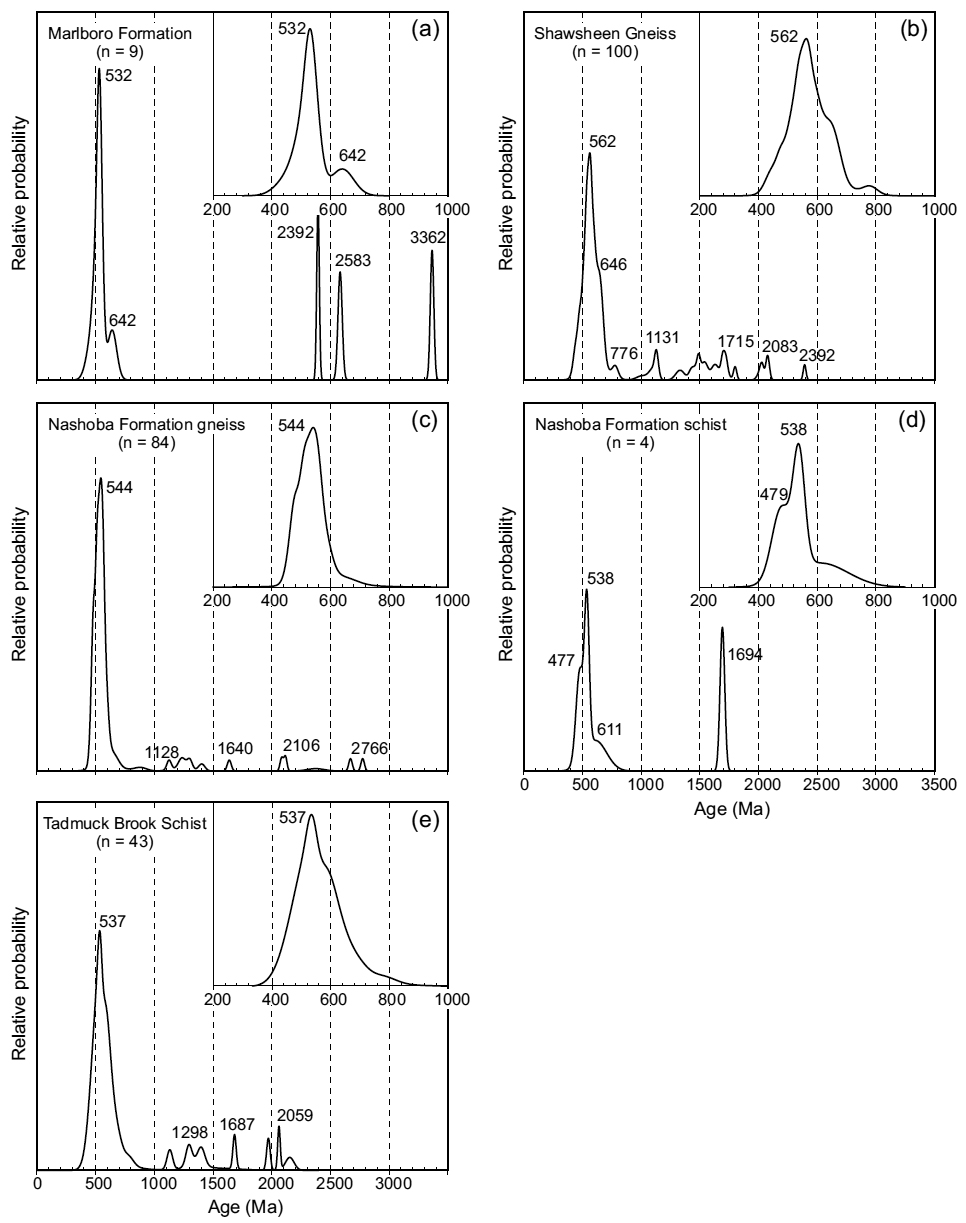 Display large image of Figure 4
Display large image of Figure 4
21 The Marlboro Formation occurs in the southeastern Nashoba terrane (Fig. 2). It is composed largely of hornblende-plagioclase amphibolite, but it also contains felsic granofels, gneiss and metasedimentary rocks that commonly include rusty weathering sillimanite-bearing schist (Bell and Alvord 1976; DiNitto et al. 1984; Goldsmith 1991a; Kopera et al. 2006). The amphibolites include rocks with basaltic and basaltic-andesite compositions with inferred arc, MORB and alkalic signatures. Whole-rock major and trace-element geochemistry and Sm–Nd isotopes indicate that they formed in a primitive volcanic arc/back-arc setting (DiNitto et al. 1984, Goldsmith 1991a, Kay et al. 2017) with minimal crustal contamination (Kay et al. 2009, 2017; Walsh et al. 2015, 2021). This arc has been interpreted to be the source for the majority of the metasedimentary rocks in the Nashoba terrane (Hepburn and Munn 1984, Goldsmith 1991a, Kay et al. 2017).
22 Zircon in metasedimentary rocks of the Marlboro Formation is rare, and commonly metamict. In order to obtain enough grains for a statistical representation, the Marlboro Formation was sampled in four different locations (Fig. 2; Loan 2011). Of the approximately 150 kg of rock processed, a total of only 9 zircon grains yielded concordant data. The data were combined as one sample, MLMRC (Table A2). Sample MLMR1 is from a rusty weathering, black to dark-grey garnet-muscovite-biotite-quartz (± sillimanite) schist interlayered with a biotite-quartz-hornblende-plagioclase amphibolite. Garnet and sillimanite are present in thin layers within the schist and the unit is locally mylonitic. The sample was collected from the pelitic layers only and yielded four concordant analyses. Sample MLMR2 is from a silvery to dark-grey, rusty weathering, fine-grained garnet-biotitemuscovite-quartz schist. It resulted in one concordant analysis. Sample MLMR5 showed two distinct layers in hand specimen: (1) a muscovite-rich schistose layer and (2) a coarser-grained quartz-rich layer with larger, black, quartz crystals. Black quartz forms due to radiation damage (Klein and Hurlbut 1993). The radiation damage extended to the zircons, resulting in rusty, amorphous, highly metamict grains that gave no concordant data. Sample MLMR6 is from a rusty, heavily weathered garnet-bearing schist that yielded four concordant analyses.
23 The youngest detrital zircon analysis from the combined Marlboro Formation samples yielded a 206Pb/238U age of 470 ± 46 Ma. Sample MLMR6 contained the oldest grain found in the Nashoba terrane with a core of ~3.36 Ga and a rim of ~2.58 Ga. The relative probability plot of the Marlboro Formation shows a peak in age at ~532 Ma and a minor peak at ~642 Ma (Fig. 4a).
24 The Shawsheen Gneiss (Fig. 2) is separated from the Nashoba Formation by the Fish Brook Gneiss and the Ass-abet River fault zone (Zen et al. 1983; Goldsmith 1991a). It is generally quartz-plagioclase-muscovite-biotite schist to paragneiss, which is interpreted to have been derived from the detritus of volcanic rocks of intermediate to mafic composition (Olszewski 1980). Sample MLSG1 is a medium- grained garnet-plagioclase-muscovite-biotite-quartz (± sillimanite) schist to gneiss collected from multiple locations around an industrial park to ensure that a statistical representation of detrital zircon was analyzed.
25 The Shawsheen Gneiss was previously dated by Olszewski (1980) using U–Pb analyses of zircon on multiple-grain fractions. The resulting discordia chord yielded 2042 ± 52 Ma upper and 517 ± 16 Ma lower intercept ages, but because these are based on only three zircon fractions (Olszewski 1980), the interpretation may not be accurate. Sample MLSG1 yielded 100 concordant detrital zircon analyses. The weighted average 206Pb/238U age of the three youngest detrital zircon analyses is 470 ± 22 Ma (MSWD = 0.26). The main age population in the sample is ~562 Ma, and a minor population exists at ~646 Ma (Fig. 4b). In addition, there are small age clusters at ~2.1–2.0 Ga, ~1.8–1.3 Ga and ~1.1 Ga, and a single grain at ~2.4 Ga.
26 The Nashoba Formation occupies about one-third of the Nashoba terrane and is composed largely of biotite-feldspar gneiss and biotite ± sillimanite schist with subordinate calcsilicate gneiss, impure feldspathic quartzite and pelitic schist (Bell and Alvord 1976; Zen et al. 1983; Hepburn and Munn 1984; Goldsmith 1991a). Hornblende amphibolite dominates the Boxford Member (Bell and Alvord 1976) along the eastern margin of the formation. The Nashoba Formation is metamorphosed in the sillimanite and sillimanite - K-feldspar zones. Samples of the gneiss, schist and calc-silicate gneiss were analyzed.
27 The Nashoba Formation gneiss (sample MLNB1; Fig. 2) is from a garnet-biotite-muscovite-plagioclase-quartz- (± sillimanite) gneiss. The unit contained interbedded layers of mylonitic gneiss with a few ~4 cm thick strongly sheared quartz veins. Areas with large quartz inclusions were not used. The sample yielded 84 concordant detrital zircon analyses. The three youngest grains yielded a weighted average 206Pb/238U age of 462 ± 20 Ma (MSWD = 0.061). The major age population is ~544 Ma (Fig. 4c). In addition, there are a few ~2.8–2.6 Ga, ~2.4 Ga, ~2.1 Ga, ~1.6 Ga, ~1.4–1.1 Ga zircons.
28 The Nashoba Formation schist (sample MLNS1; Fig. 2) is a garnet-muscovite-biotite-quartz- (± sillimanite) schist. Of the abundant schistose units in the Nashoba terrane this sample was selected because of its minimal quartz vein inclusions. However, the sample yielded only 4 concordant detrital zircon analyses, the other 118 concordant analyses being interpreted as metamorphic (Fig. 4d). The youngest detrital zircon in the Nashoba Formation schist yielded a 206Pb/238U age of 477 ± 32 Ma. Two remaining detrital grains yielded 206Pb/238U ages of 538 ± 20 Ma, 611 ± 94 Ma, and one a 207Pb/206Pb age of 1694 ± 32 Ma.
29 The Nashoba Formation calc-silicate gneiss outcrop (sample MLBM1; Fig. 2) includes rock types ranging from rusty garnet-bearing schist to calc-silicate gneiss and amphibolite. The calc-silicate gneiss sampled contains diopside, actinolite, phlogopitic biotite, and abundant titanite. It likely formed from original more dolomitic layers (Hepburn and Munn 1984). The unit is deformed by a shear zone separating the more calcareous layers of the outcrop from the schistose layers. Samples were taken away from the shear zone and included a mixture of calc-silicate rocks with and without the micaceous lenses. No detrital zircon was found and all zircon analyzed is interpreted to be of metamorphic or carbonate fluid/hydrothermal origin as discussed below.
30 The Tadmuck Brook Schist is a rusty-weathering micaceous schist with thin quartzose layers that lies along the northwestern boundary of the Nashoba terrane (Fig. 2) adjacent to the Clinton-Newbury fault zone. The metamorphic grade increases from greenschist facies in the NW to upper amphibolite facies in the SE within the ~1 km thick unit (Jerden and Hepburn 1996; Jerden 1997). It has been uncertain whether the Tadmuck Brook Schist is part of the Nashoba terrane or of the Merrimack belt (Goldsmith 1991a). Sample (MLTMBC; Fig. 2) is from a sillimanite-bearing sulfidic mica schist in the high-grade (southeastern) member and contains thin quartz-rich layers. The Tadmuck Brook Schist has unique mineralogy as it is the only unit that contains scheelite, a fluorescent tungsten-bearing mineral that is commonly associated with high-temperature hydrothermal veins and contact metamorphism in skarns (Klein and Dutrow 2007). The unit also contains abundant titanite. This sample yielded 47 concordant detrital zircon analyses. Due to the small grain size, all the zircons in this sample were ablated using a 30×30 μm square raster, which led to increased uncertainty. The youngest three detrital zircon analyses yielded a weighted average of 206Pb/238U ages of 462 ± 47 Ma (MSWD = 0.049). The sample had a major ~537 Ma age peak, and scattered ~2.2–1.9 Ga, ~1.7 Ga and ~1.4–1.1 Ga ages (Fig. 4e).
CA-TIMS zircon analysis
31 Youngest zircon grains of selected samples were re-dated using CA-TIMS methods (Table 1) with the purpose to better constrain the maximum depositional age of the formations. While three or four grains per sample were selected for analysis, not all survived sample preparation and chemical abrasion. Only one grain remained from the Nashoba terrane, sample MLNB1 from the Nashoba Formation gneiss. Its 206Pb/238U CA-TIMS age is 465.9 ± 0.7 Ma, which is within error of the weighted average of 206Pb/238U LA-ICPMS ages of 462 ± 20 Ma for the three youngest grains from this sample (Table A2; see above).
Metamorphic zircon
32 Nashoba terrane samples from the five formations other than the calc-silicate gneiss contained 159 zircons interpreted as metamorphic per the criteria listed above (Fig. 5). They range from ~454 Ma to 324 Ma, with the results for the individual formations as follows: Marlboro Formation, ~443–324 Ma (weighted average of 206Pb/238U ages of 396 ± 20 Ma, n = 10, MSWD = 1.6); Shawsheen Gneiss, 422 ± 19 Ma (n = 5, MSWD = 0.27); Nashoba Formation gneiss ~454–353 Ma (or weighted average age of 408 ± 13 Ma, n = 22, MSWD = 5.6); Nashoba Formation schist ~433–327 Ma (or weighted average age of 377.2 ± 4.4 Ma, n = 118, MSWD = 1.9); and Tadmuck Brook Schist 433 ± 33 Ma (n = 4, MSWD = 0.031) (cf. Table A2).
 Display large image of Figure 5
Display large image of Figure 5
33 The calc-silicate gneiss (MLMB1) yielded 61 206Pb/238U zircon ages of ~434–310 Ma (or weighted average age of 354.4 ± 5.9 Ma, n = 61, MSWD = 2.2; Fig. 5f). Fifty-three of these zircon analyses gave Th/U ratios <0.20, with only one Th/U ratio below 0.10, and 9 analyses gave ratios of 0.20– 0.37. These Th/U ratios are higher than the typical <0.1 ratio for metamorphic zircon (Rubatto 2017; Yakymchuk et al. 2018). The calc-silicate gneiss is within the stratified succession of the Nashoba terrane, is gradational with the rest of the Nashoba Formation and is similarly metamorphosed under upper amphibolite facies conditions. There is no field evidence to suggest that it is much younger than the other Nashoba terrane rocks. Furthermore, while Th/U ratios >0.1 are not typical for metamorphic zircon, they are not uncommon (Rubatto 2017; Yakymchuk et al. 2018). Yakymchuk et al. (2018) conclude that “igneous zircon rarely has Th/U < 0.1 and metamorphic zircon can have values ranging from <0.01 to >10.” For these reasons, the ages of zircons in the calc-silicate gneiss are interpreted as metamorphic, likely having formed in the presence of fluids.
34 Thus, we interpret metamorphic zircon in the Nashoba terrane to have grown between ~433 Ma and ~356 Ma, based on the weighted averages of 206Pb/238U ages. The Marlboro Formation, Shawsheen Gneiss, Nashoba Formation Gneiss and Tadmuck Brook Schist generally record older metamorphic zircon ages (weighted average age of 408.0 ± 8.8 Ma, n = 41, MSWD = 3.5) while zircon growth continued until somewhat later in the Nashoba Formation schist and especially the calc-silicate gneiss (weighted combined average age of 368.4 ± 4.0 Ma, n = 180, MSWD = 3.8).
Merrimack belt
Sample descriptions and LA-ICPMS detrital zircon
35 The six formations analyzed from the Merrimack belt are presented below in a general NE to SW order (Fig. 2). The Eliot Formation consists of thinly layered grey to green phyllite, calcareous feldspathic metasiltstone and quartzite, quartz-mica schist, and calc-silicate gneiss (Lyons et al. 1997; Hussey et al. 2010, 2016). It has been interpreted as Silurian–Ordovician based on correlation with parts of the Casco Bay Group in Maine (Hussey et al. 2010). Sample KSELI from SE New Hampshire (Fig. 2) consists of generally thin-bedded alternations of tan-grey weathering, turbiditic calcareous quartzite and silvery dark phyllite (Fargo and Bothner 1995). Quartz veins were avoided during sample collection and removed prior to crushing. The sample yielded 119 concordant analyses. The weighted average of the 206Pb/238U ages of the four youngest detrital zircon grains is 409 ± 19 Ma (MSWD = 0.046). The major population peaks at ~446 Ma (Fig. 6a). Two grains are ~2.9 Ga and ~2.7 Ga and other ages spread between ~1.9 Ga and ~512 Ma.
 Display large image of Figure 6
Display large image of Figure 6
36 The Kittery Formation consists of feldspathic and calcareous, ankeritic metaturbidite successions and minor fine-grained metasiltstone and feldspathic quartzite (Robinson and Goldsmith 1991; Bothner and Hussey 1999; Hussey et al. 1984, 2010, 2016). The fine-grained, thinly bedded to laminated rocks and thicker quartzitic beds contain cross lamination and other primary sedimentary structures (Hussey et al. 1984, 2010, 2016). Several paleocurrent indicators in the Kittery Formation in New Hampshire suggest a source to the southeast (Rickerich 1983, 1984; Hussey et al. 1984). Sample KSKTI (Fig. 2) was taken from an outcrop in SE New Hampshire, immediately across the Piscataqua River from the type locality in Maine (Katz 1917; Bothner and Hussey 1999) and is a tan weathering, grey to purplish, massive, fine-grained, feldspathic quartzite and quartzitic phyllite. It yielded 101 concordant analyses. The weighted average of 206Pb/238U ages of the four youngest detrital zircon grains is 413 ± 13 Ma (MSWD = 0.089). The main age group is ~461 Ma, and older populations are ~2.8 Ga, ~1.8– 1.0 Ga, and ~769 and 543 Ma (Fig, 6b).
37 The Berwick Formation is composed primarily of thin to thick tabular and lenticular beds of calcareous metasiltstone, biotite-rich metasiltstone, purplish biotite-quartz-feldspar granofels, and fine-grained metasandstone (Robinson and Goldsmith 1991; Fargo and Bothner 1995; Hussey et al. 2016). Some layers contain actinolite were metamorphosed to the greenschist facies, while at higher metamorphic grade, diopside, hornblende, and plagioclase are common (Robinson and Goldsmith 1991). Most of the Berwick Formation is in the garnet zone, although portions reach the sillimanite zone (Zen et al. 1983; Robinson and Goldsmith 1991; Hussey et al. 2016). Sample KSBWI, taken from NE Massachusetts (Fig. 2) consists of a fine-grained, light-grey to purplish-grey calcareous metasiltstone with beds a few cm to 1 m thick and interbeds of a dark-grey micaceous phyllite. It yielded 133 concordant analyses. The five youngest zircon grains provided a weighted average of 206Pb/238U ages of 409 ± 12 Ma (MSWD = 0.27). Zircon yielded a main age peak at 443 Ma, a few analyses at ~2.8–2.7 Ga and ~2.3 Ga and small populations between ~1.8 Ga and ~1.0 Ga and at ~634 Ma (Fig. 6d).
38 The Oakdale Formation is a thick unit composed of inter-layered brownish-grey to light-grey ankeritic metasiltstone, green-grey to purplish-grey impure quartzite, muscovite schist, and greenish-grey, grey, and dark brown calcareous phyllite (Grew 1973; Hepburn 1976; Peck 1976; Zen et al. 1983; Robinson and Goldsmith 1991). Sample KSOKI (Fig. 2) is from the type area in east-central Massachusetts (Emerson 1917; Hepburn 1976; Robinson and Goldsmith 1991) and consists of a grey weathering, light-grey quartz-rich phyllite and micaceous phyllite, interbedded with tan to grey-green weathering beds of metasiltstone and impure quartzite. It yielded 108 concordant zircon analyses. The youngest detrital zircon age population of the four youngest grains is 431 ± 12 Ma (weighted average 206Pb/238U age, MSWD = 0.69) and the main age peak is ~451 Ma (Fig. 6c). One analysis is ~2.7 Ga, and other ages show a continuous spread between ~2.0 Ga and the main age population.
39 The Worcester Formation, also called Worcester Phyllite, is a turbidite succession composed of grey and dark-grey carbonaceous slate, well foliated micaceous phyllite or schist containing andalusite, including chiastolite, inter-bedded with layers a few centimetres to one metre thick of impure quartzite, calc-silicate or metasiltstone (Grew 1973; Hepburn 1976; Peck 1976; Robinson and Goldsmith 1991). Sample KSWSI (Fig. 2) was taken largely from turbiditic sandy layers in a grey-weathering, light-grey, fine-grained turbidite with fissile phyllite interlayered with metasandstone and siltstone layers that range from a few cm to ~0.5 m thick. The sample yielded 138 concordant analyses. The weighted average of 206Pb/238U ages of the four youngest grains is 436 ± 9 Ma (MSWD = 0.89). The main age group is ~470 Ma. One grain is ~2.2 Ga, and other populations are between ~2.0 Ga and ~950 Ma, and ~800–470 Ma (Fig. 6e).
40 The Paxton Formation contains several sub-lithologies (Robinson and Goldsmith 1991). In the area of our study it is composed predominantly of grey-weathering, slabby, quartz-plagioclase-biotite granofels and well-layered purplish biotite granofels with calcic plagioclase (Robinson et al. 1982; Robinson and Goldsmith 1991). Sample KSPXIII from east-central Massachusetts (Fig. 2), is composed of a greenschist grade (garnet zone or lower at the locality sampled) laminated, slabby, quartz-rich, purple-grey granofels to schist. It yielded 113 concordant analyses. The youngest detrital zircon age population for the Paxton Formation is 426 ± 6 Ma (MSWD = 0.56) based on the weighted average of the 206Pb/238U ages of the ten youngest grains. The main peak is ~463 Ma with a smaller peak at ~431 Ma. Two analyses are ~2.6 Ga and most other analyses are between ~1.8–0.9 Ga with a few grains between ~700 and ~528 Ma (Fig. 6f).
CA-TIMS zircon analyses
41 Youngest zircon grains of selected samples from the Merrimack belt were re-dated using CA-TIMS methods (Table 1; Fig. 7), but as with the Nashoba terrane samples above, not all survived the processing. All CA-TIMS data for the Merrimack belt were within error of, or older (some much older, see below) than the LA-ICPMS data (Tables 1, A2). The youngest CA-TIMS 206Pb/238U ages from five grains from the Kittery, Paxton and Oakdale formations ranged from 434 Ma to 425 Ma.
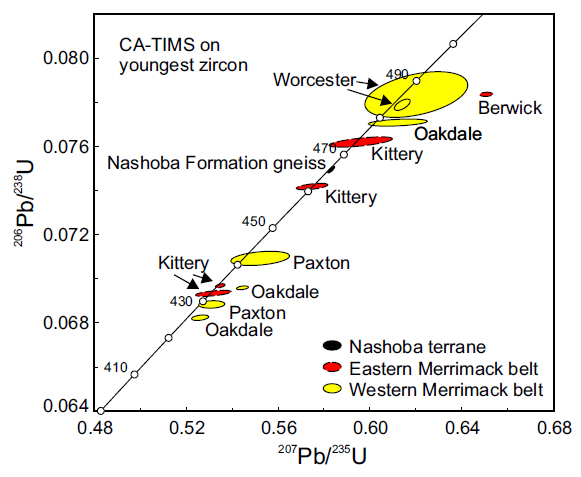 Display large image of Figure 7
Display large image of Figure 7
Tower Hill Formation
42 The Tower Hill Formation is a relatively thin unit (up to ~130 m thick) along the Clinton-Newbury fault zone (Fig. 2). It is light-grey to buff and consists of massive orthoquartzite beds and subordinate dark-grey phyllite or mica-schist containing biotite, and locally garnet porphyroblasts (Grew 1970, 1973; Peck 1976; Hepburn 1976). However, in places it includes successions of phyllite reaching 65 m in thickness (Robinson and Goldsmith 1991). It is located along the Clinton-Newbury fault and its position in the stratigraphy and potential affinity with the Merrimack belt or Nashoba terrane are unclear (see Robinson and Goldsmith 1991). At the location of sample KSTHI (Fig. 2) in Berlin, Massachusetts it consists of fine-grained, light to dark-grey, massive quartzite. The youngest detrital zircon age population within the 106 concordant analyses is 513 ± 15 Ma (MSWD = 1.01) based on the weighted average of 206Pb/238U ages of three grains. One analysis (mr12a30) yielded a 206Pb/238U age of 463 ± 9 Ma but is not part of a population. The main population is ~630 Ma with a satellite peak at ~530 Ma and a continuum of ages exists from there tapering off to ~1.8 Ga (Fig. 6g). Three grains are ~2.9 Ga and ~2.1 Ga.
DISCUSSION
Nashoba terrane
Age of deposition
43 Based on the LA-ICPMS results, the youngest detrital zircon population of all samples of the Nashoba terrane combined is 466 ± 13 Ma (MSWD = 0.12, n = 11). Given this, and taking the errors into account, the maximum ages of the Nashoba terrane metasedimentary rocks could range from Early to Late Ordovician. If the higher precision but single CA-TIMS age of 465.9 ± 0.7 Ma (Table 1; Fig. 7) on grain mr02a06 of the Nashoba Formation gneiss (LA-ICPMS age of 480 ± 13 Ma) is representative, portions of the Nashoba Formation could have a maximum depositional age of early Middle Ordovician. Similar results were reported by Walsh et al. (2021) for two samples from the Nashoba Formation in southern Massachusetts and its correlative in Connecticut, the Tatnic Hill Formation, where detrital zircons gave an age of deposition between the ~485 Ma age of the youngest detrital zircon, and the ~435 Ma age of metamorphism. Because the 515 Ma granitic Grafton Gneiss cuts some of the mafic metaigneous rocks of the Marlboro Formation, and a ~500 Ma feldspathic granofels structurally overlies these (Walsh et al. 2009, 2011a, b, 2021), at least part of the Marlboro Formation is late Cambrian or older. The scarcity of detrital zircon in the metasedimentary rocks of the Marlboro Formation may indicate that they are primarily derived from the local, largely mafic, volcanic rocks of the Marlboro Formation. Thus, at least parts of the Marlboro Formation, and likely portions of the other Nashoba terrane units, are Cambrian, while other units, or parts of them, are Ordovician or younger.
44 The Assabet River fault zone (Fig. 2) is a major fault zone within the Nashoba terrane, separating the Nashoba Formation and Tadmuck Brook Schist to the northwest from the Shawsheen Gneiss and Marlboro Formation to the southeast (Bell and Alvord 1976; Hepburn and DiNitto 1978; Zen et al. 1983; Goldsmith 1991a, b; Kopera et al. 2006). To determine the significance of this fault zone, samples from the northwestern and southeastern Nashoba terrane were plotted separately in Figs. 8a and b. Samples from both sides show very similar patterns with a significant ~560–540 Ma detrital zircon age population and minor Mesoproterozoic and Paleoproterozoic populations. Archean grains are rare in both. The similarity of these data indicates that there is no significant difference in detrital age populations across the Assabet River fault zone and that it thus does not represent a terrane boundary. The combined Nashoba terrane data are plotted in Fig. 8c. The similarity of the detrital zircon age distribution in the Tadmuck Brook schist (Fig. 4e) to that of the other units of the Nashoba terrane, and its difference from the distributions in the Merrimack belt (Figs. 6, 8f) indicates that it is part of the Nashoba terrane.
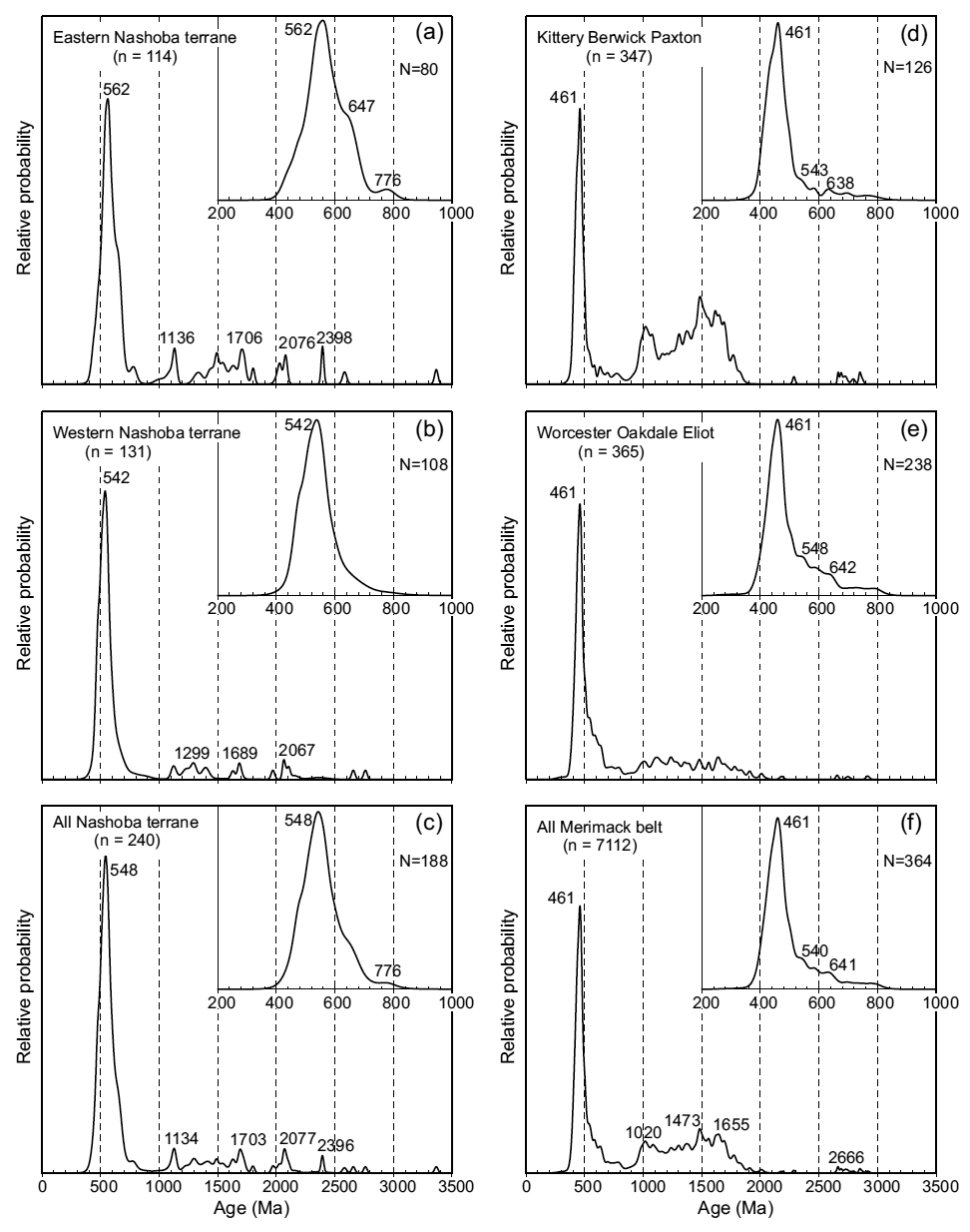 Display large image of Figure 8
Display large image of Figure 8
Provenance and correlations
45 The Nashoba terrane has been interpreted as a primitive arc/back-arc complex (Hepburn et al. 1995; Kay et al. 2009, 2011, 2017; Walsh et al. 2011b, 2015, 2021). Archean and Proterozoic detrital zircon and Mesoproterozoic depleted mantle Sm/Nd model ages (Kay et al. 2017) suggest that this complex formed on older crustal material. Paleoproterozoic and Mesoproterozoic detrital zircon in the metasedimentary rock samples support this, and similar youngest zircon age populations and provenance in all four units of the Nashoba terrane indicate that they all formed as part of the same early Paleozoic arc/back-arc complex.
46 Both Avalonia and at least part of Ganderia experienced active ~650–590 Ma magmatism (e.g., Murphy et al. 2004; Fyffe et al. 2009; Satkoski et al. 2010; Thompson et al. 1996, 2007, 2010; Pollock et al. 2009; van Staal et al. 2009, 2020; Barr et al. 2012, 2019). For Ganderia, this abundant arc magmatism continued until the Cambrian, whereas in Avalonia it ceased or greatly decreased by ~565 Ma as Avalonia became a stable platform (Barr et al. 2003a; Murphy et al. 2004; Samson et al. 2005; Rogers et al. 2006; Hibbard et al. 2007; van Staal et al. 2009, 2020; van Staal and Barr 2012). Detrital zircon age populations from the metasedimentary units of the Nashoba terrane are generally consistent with those from the Ediacaran–early Silurian Ganderian rocks from Newfoundland, New Brunswick and east-central Maine (Fig. 9b; e.g., White and Barr 1996; Barr et al. 2003b, 2019; Valverde-Vaquero et al. 2006b, Pollock et al. 2007, 2009; Schulz et al. 2008; Fyffe et al. 2009; Ludman et al. 2018). The large ~540 Ma detrital zircon age population in all units, and the smaller ~640 Ma age population with minor Mesoproterozoic and Paleoproterozoic populations suggest a Ganderian affinity (Barr et al. 2014; Rogers et al. 2006; Fyffe et al. 2009; Pollock et al. 2007, 2009). It is less consistent with Avalonia, which is characterized by a large ~640 Ma population and a smaller ~540 Ma population (Fig. 9c; cf. Keppie et al. 1998; Thompson and Bowring 2000; Barr et al. 2003b, 2012; Murphy et al. 2004; Pollock et al. 2009; Satkoski et al. 2010; Thompson et al. 2014). Strongly negative εNd (500) values and Paleoproterozoic model ages for the metasedimentary rocks in the Nashoba terrane (Kay et al. 2017) are also characteristic for Ganderian sedimentary rocks (Samson et al. 2000; Schofield and D’Lemos 2000; Rogers et al. 2006; Pollock et al. 2012) and not for typical Avalonian crust (Nance and Murphy 1996; Barr et al. 1998; Hibbard et al. 2007 Thompson et al. 2012). We therefore interpret the Nashoba terrane as having Ganderian affinity.
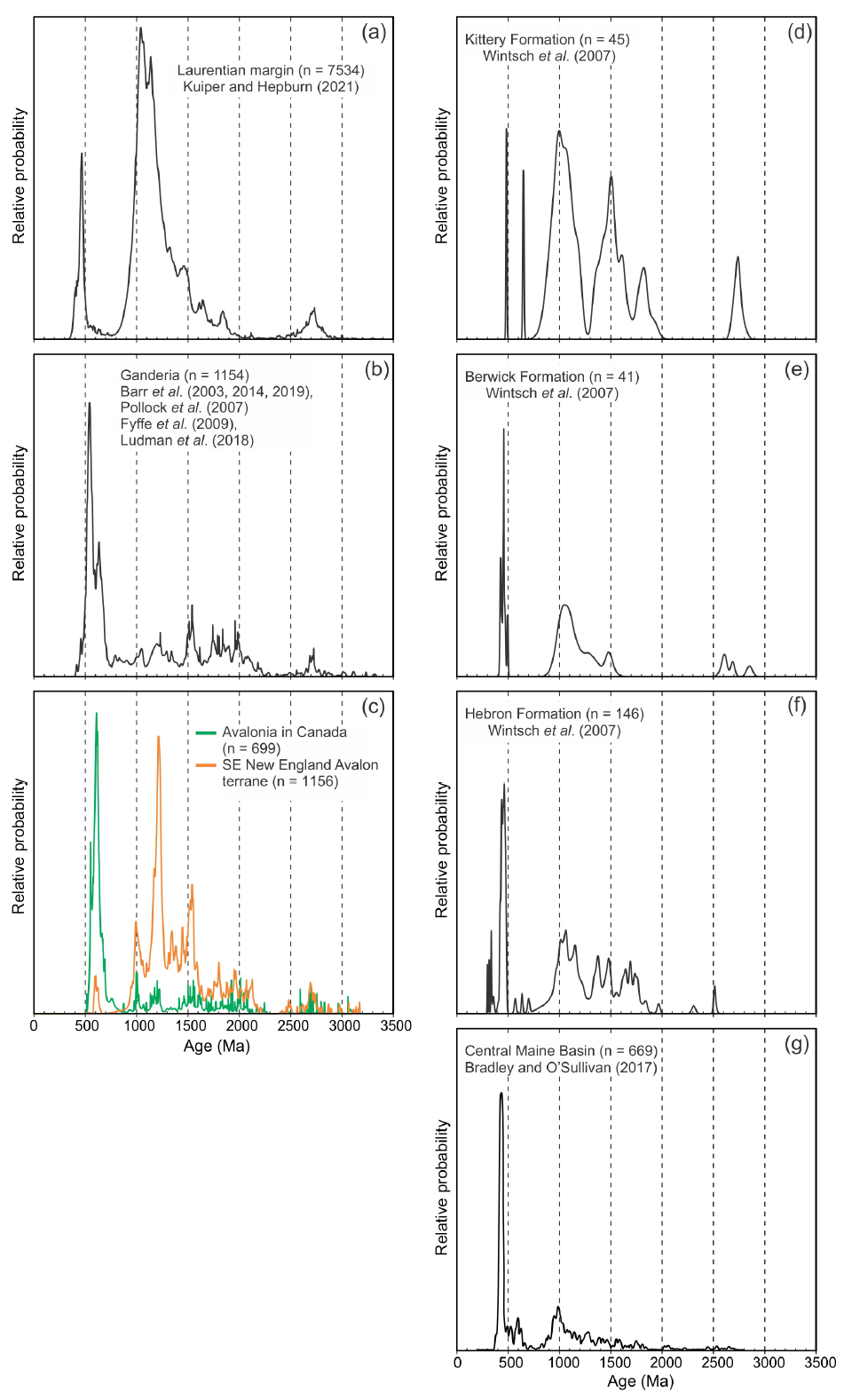 Display large image of Figure 9
Display large image of Figure 9
47 Ganderia is interpreted to have formed along the Iapetus ocean-facing Amazonian margin of Gondwana in the Neoproterozoic and rifted away in the middle Cambrian, opening the Rheic ocean behind it (Figs. 10a, b) (e.g., van Staal et al. 1996, 2009, 2012, 2020; Fyffe et al. 2009, 2011; Schulz et al. 2008; Pollock et al. 2012; Barr et al. 2014; van Staal and Barr 2012; Willner et al. 2014). Prior to rifting a ~550–528 Ma extensive arc complex developed on the Ganderian margin (Fyffe et al. 2011; van Staal and Barr 2012). It formed the basement to the ~515–485 Ma Penobscot arc/back-arc complex that developed on the leading edge of Ganderia as it moved into the Iapetus ocean (Fig. 10b) (Valverde-Vaquero et al. 2006a; Rogers et al. 2006; Murphy et al. 2006; van Staal et al. 2009; Fyffe et al. 2009, 2011; Zagorevski et al. 2007a, b, 2010; van Staal and Barr 2012). At ~486–478 Ma, the Penobscot arc and back-arc fragments consolidated outboard of Laurentia during the Penobscot orogeny (Fig. 10c) (Zagorevski et al. 2007b, 2010; van Staal et al. 2009; Johnson et al. 2009, 2012; van Staal and Barr 2012). Penobscot arc/ back-arc rocks are found, south of Newfoundland, in the Brookville, New River and Annidale belts in New Brunswick, the Bras d’Or belt in Cape Breton Island, and the Ells-worth Formation and St. Croix terrane in eastern Maine and share many characteristics with the Nashoba terrane (White et al. 1994; Barr et al. 1998; Schulz et al. 2008; Johnson et al. 2009, 2012; Fyffe et al. 2011; van Staal and Barr 2012).
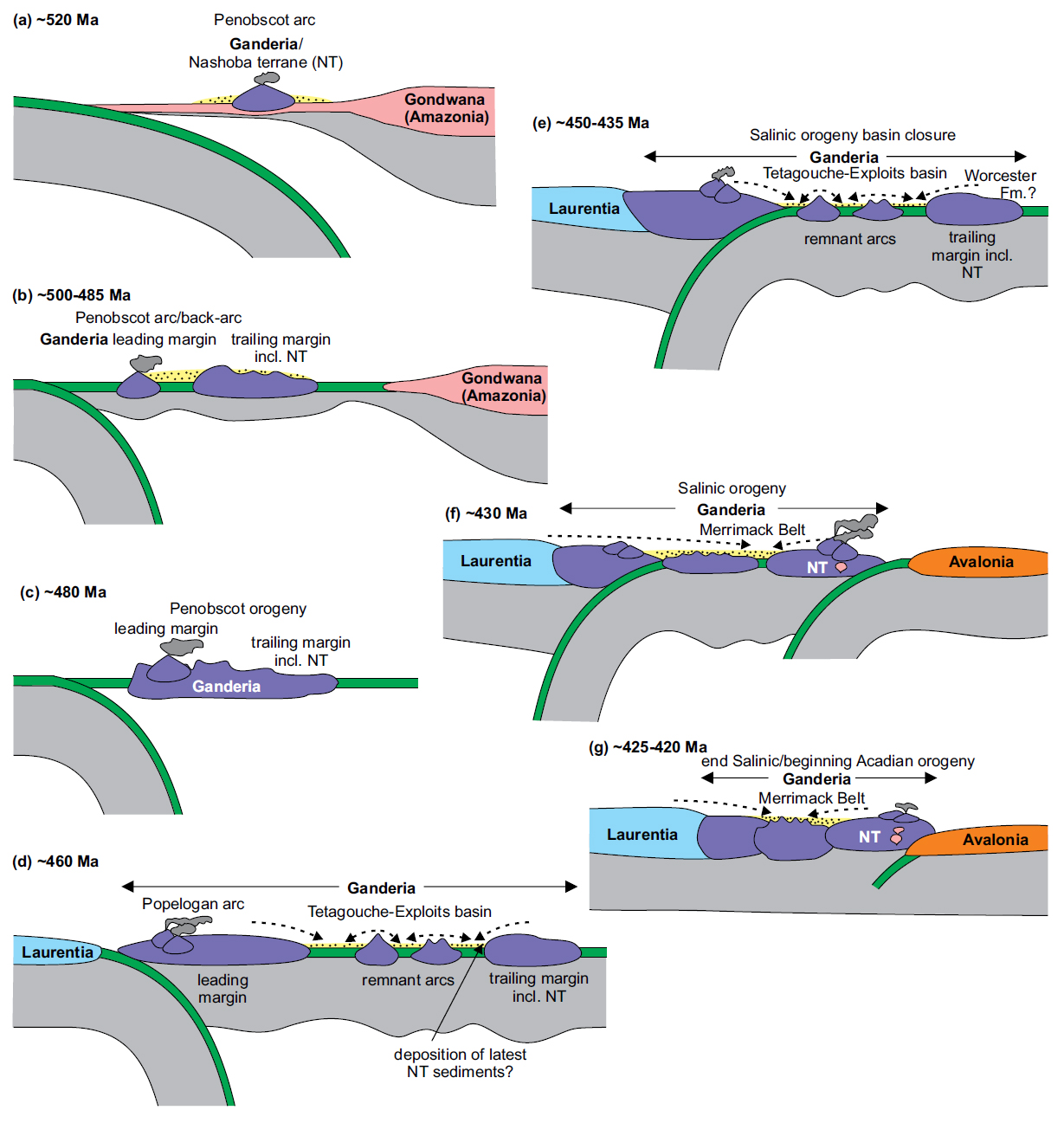 Display large image of Figure 10
Display large image of Figure 10
48 Shortly after the Penobscot orogeny, a second expansive arc/back-arc complex (Popelogan-Victoria cycle) formed from ~478–453 Ma on the remnants of the now consolidated Penobscot arc/back-arc deposits (Fig. 10d) (e.g., van Staal 1994; van Staal et al. 1998, 2016; Zagorevski et al. 2010; van Staal and Barr 2012; Wilson et al. 2017) and opened up the expansive Tetagouche and Exploits back-arc basins in Atlantic Canada – New England and in Newfoundland, respectively. These basins divided the Ganderian terrane into a separate active leading margin and a passive trailing margin (where the Nashoba terrane is located). The leading margin collided with Laurentia at about 455–450 Ma (Taconic phase 3 orogeny of van Staal et al. 2009). During the next ~20–25 myr the Tetagouche-Exploits basin gradually closed by west-directed subduction under Laurentia (Salinic orogenic cycle) (Figs. 10e, f) until the trailing margin of Ganderia collided with Laurentia in the terminal 426–420 Ma Salinic orogeny (Fig. 10g) (e.g., van Staal et al. 1998, 2003, 2008, 2012, 2016; Valverde-Vaquero et al. 2006a; Zagorevski et al. 2008; Fyffe et al. 2011; Zagorevski and van Staal 2011; van Staal and Barr 2012).
49 In the Nashoba terrane, igneous rocks of the ~540–500 Ma Marlboro Formation, the 515 Ma Grafton Gneiss and the 499 Ma Fish Brook Gneiss (Hepburn et al. 1995; Acaster and Bickford 1999; Walsh et al. 2011a, 2015, 2021) originated during the time of formation of the Cambrian Penobscot arc/back-arc complex (Figs. 10a, b) or its Ediacaran–Cambrian basement. An abundance of detrital zircon of that age in metasedimentary units of the Nashoba terrane reflects internal sources within the Penobscot arc/back-arc complex and its basement. Older zircon grains in the Nashoba terrane were eroded into the sedimentary basins from either Gondwanan (Amazonian) sources prior to the Cambrian rifting and drifting of Ganderia, or originated from reworked basement rocks beneath the Nashoba terrane. Such Proterozoic basement is exposed beneath Penobscot-cycle Ganderian rocks in the Brookville and New River terranes and on Grand Manan Island in New Brunswick (Johnson et al. 2009, 2012; Fyffe et al. 2009, 2011; Pollock et al. 2012; van Staal and Barr 2012; Fyffe 2014; Barr et al. 2019), the Bras d‘Or terrane in Cape Breton Island (Barr et al. 1998; van Staal and Barr 2012) and the Islesboro block in coastal Maine (Reusch et al. 2018, 2021). The combined LA-ICPMS youngest detrital zircon age population of all samples from the Nashoba terrane (466 ± 13 Ma) and the single CA-TIMS age (465.9 ± 0.7 Ma) suggest that Ordovician metasedimentary rocks also exist in the terrane and may have formed during the Popelogan tectonic cycle (Fig. 10d).
Metamorphic zircon
50 The Nashoba terrane contains abundant metamorphic zircon grains. These show a significant spread of weighted average ages between ~433 Ma and ~356 Ma (Fig. 5) and primarily indicate zircon growth during the Acadian orogeny. Younger zircon ages, while showing scatter and large uncertainties, likely reflect growth and/or recrystallization that extended into the Neoacadian and Alleghanian orogenies. Metamorphic zircon formed prior to ~425 Ma may have originated during the earlier Salinic orogeny. Our ages are consistent with published ages of metamorphism in the Nashoba terrane using various methods (Hepburn et al. 1995; Wintsch et al. 2007; Stroud et al. 2009; Walsh et al. 2013a, 2015, 2021; Buchanan et al. 2016a, b; Severson 2020). Because the precision of our ages is not higher than those reported previously, and because of consistency between the various data sets, we will not discuss the ages of metamorphism further.
Tower Hill Formation
Age of deposition and correlations
51 The youngest LA-ICPMS detrital zircon age population in the Tower Hill Formation is 513 ± 15 Ma (3 grains), considerably older than any of the six formations sampled from the Merrimack belt (Figs. 6, 8f). A single grain from this unit (not included in the grouping at 513 Ma) has a LA-ICPMS 206Pb/238U age of 463 ± 9 Ma, which is within error of the youngest age population of the Nashoba terrane. However, the ~513 Ma population is older than any youngest populations in the metasedimentary rocks of the Nashoba terrane and other aspects of the zircon population in the Tower Hill Formation, such as the 630 Ma main age peak, are different from any of the other samples (Figs. 4, 8c). Of particular interest is the ~950–750 Ma age population that is not characteristic for known Avalonian or Ganderian rocks.
52 The 513 ± 15 Ma youngest age population of the Tower Hill Formation is similar to the maximum ages of deposition for Cambrian rocks found in several Ganderian terranes in New England and New Brunswick. These include the Ellsworth Formation of the Ellsworth terrane, the Calais Formation of the St. Croix terrane, and the Baskahegan Lake Formation of the Miramichi terrane (Fyffe et al. 2009). However, these formations do not show a large peak at ~630 Ma. Basement rocks (Martinon Fm.) below the Ganderian Brookville terrane and on Grand Manan Island in New Brunswick (Flagg Cove and Long Pond Bay Formations, Fyffe et al. 2009; Fyffe 2014; Barr et al. 2019) do show a Neoproterozoic peak of approximately this age. Rocks with both Cambrian youngest detrital zircon age populations and ~630 Ma peaks occur in some samples in the Moretown, Albee and Dead River formations of the Moretown terrane in western Massachusetts, Vermont, New Hampshire and western Maine (Karabinos et al. 2017) and the Ganderian Kedears Hill greywacke of North Islesboro, Maine (Reusch et al. 2018, 2021). However, because none of their detrital zircon signatures is similar to the Tower Hill formation, no specific correlations can be made. The detrital zircon ages do indicate that the Tower Hill Formation is not a part of the Merrimack belt stratigraphy and that the boundary between the Nashoba terrane and Merrimack belt is complex and likely incorporates exotic fault-bounded slices.
Merrimack belt
Age of deposition
53 The LA-ICPMS youngest detrital zircon populations for individual formations of the Merrimack belt in southeastern New Hampshire and Massachusetts range between 436 ± 9 Ma (Worcester Formation) and 409 ± 12 Ma (Berwick Formation). The CA-TIMS 206Pb/238U ages for the five youngest detrital zircon grains from the Merrimack belt samples are between 434 and 425 Ma. Three CA-TIMS ages from the Merrimack belt are within error of LA-ICPMS analyses that were used as part of the youngest populations (Tables 1, A2). These include two grains from the Oakdale Formation (mr16b23, LA-ICPMS: 409 ± 17 Ma, CA-TIMS: 425.53 ± 0.64 Ma and mr16a24 LA-ICPMS: 436 ± 8 Ma, CA-TIMS: 433.70 ± 0.41 Ma respectively) and grain au26a47 of the Paxton Formation (LA-ICPMS: 412 ± 18 Ma, CA-TIMS: 429.16 ± 0.82 Ma). The remainder of the CA-TIMS ages on grains from the youngest groups of zircons are older than the LA-ICPMS ages, up to ~30 myr for a grain from the Worcester Formation with a CA-TIMS age of 486 Ma (Table 1). This may reflect either unaccounted for Pb-loss in the LA-ICPMS analyses or the presence of older cores that survived chemical abrasion better than overgrowths prior to analysis. These older CA-TIMS ages are not interpreted as reflecting the ages of the youngest zircon populations.
54 The CA-TIMS ages for the three youngest detrital zircons in the Oakdale and Paxton formations (434–426 Ma) are consistent with the 429 ± 5 Ma LA-ICPMS youngest detrital zircon age population (MSWD = 0.82, n = 18) for the three formations in the central Massachusetts portion of the belt (Worcester, Oakdale, and Paxton formations). The Worcester Formation is intruded by a 424 ± 3 Ma phase of the Ayer granodiorite at Eddy Pond, near Auburn, Massachusetts (U–Pb secondary ion mass spectrometry (SIMS) zircon data; Walsh et al. 2013a; Walsh and Merschat 2015), and the Oakdale Formation is intruded by the 420.1 ± 0.1 Ma Clinton facies of the Ayer granodiorite (U–Pb CA-TIMS zircon data; Charnock 2015). Therefore, the ages of these two formations are constrained between ~434 Ma and ~420 Ma (late Llandovery to Pridoli).
55 The combined youngest detrital zircon age population for the Kittery, Eliot and Berwick formations in the northeastern part of the sample area is 411 ± 8 Ma (MSWD = 0.14, n = 13). The LA-ICPMS weighted average of 206Pb/238U ages of the four youngest detrital zircon grains from the Eliot Formation is 409 ± 19 (MSWD = 0.046), of the four youngest grains from the Kittery Formation is 413 ± 13 Ma (MSWD = 0.089), and of the five youngest detrital zircon grains from the Berwick Formation is 409 ± 12 Ma (MSWD = 0.27). Two grains from the Kittery Formation youngest population yielded CA-TIMS ages of 432 Ma and 434 Ma (Table 1). The previously folded and regionally metamorphosed Kittery and Eliot formations are intruded in SE New Hampshire by the 418 ± 1 Ma Newburyport quartz diorite and the 407.4 ± 0.5 Ma Exeter diorite (U–Pb ID-TIMS and CA-TIMS zircon data; Bothner et al. 1993, 2009; Hussey and Bothner 1993; Fargo and Bothner 1995; Wintsch et al. 2007). The Berwick Formation was intruded by the 407 ± 4 Ma Devens Long Pond facies of the Aver Granite in Westford, Massachusetts (U–Pb SHRIMP, Walsh et al. 2013b, 2021). This indicates that at least the Kittery and Eliot formations must be older than 418 Ma and that the LA-ICPMS youngest average detrital zircon age for these formations is inconsistently young.
56 Based on the LA-ICPMS and CA-TIMS data and the dated intrusive rocks, the Merrimack belt units in Massachusetts and SE NH are interpreted to have been deposited between ~434 Ma and ~420 Ma. However, since the Berwick and Paxton formations are not intruded by any pre-407 Ma dated igneous rocks in the area their minimum age limit is not well constrained, and they could be somewhat younger.
Correlations and changes in provenance through time
57 In Massachusetts and SE New Hampshire, the Merrimack belt rocks have ages of deposition between ~434 and ~420 Ma, large Middle to Late Ordovician zircon populations, smaller ~500–800 Ma populations, significant Mesoproterozoic populations, and scattered Archean grains. The Mesoproterozoic populations are much more prominent in the Kittery, Berwick and Paxton formations than in the Eliot, Oakdale, and Worcester formations (Figs. 6, 8d, e). While both Laurentia and Gondwana are potential viable sources for Mesoproterozoic zircon (e.g., Murphy et al. 2004; Fyffe et al. 2009; Pollock et al. 2009; Barr et al. 2019; Figs. 9a, b), Laurentia is a better source for ~1.2–1.0 Ga zircon (e.g., Cawood and Nemchin 2001; Hibbard et al. 2007; Waldron et al. 2014, 2018; Dokken et al. 2018; Severson 2020; Kuiper and Hepburn 2021). Furthermore, ~2.2–2.0 Ga zircons are largely absent in Laurentia, while Gondwana provides some zircon of this age, and Neoproterozoic zircon is characteristic for Gondwana, but not for Laurentia (Figs. 9a, b; Pollock et al. 2007; Waldron et al. 2009, 2014; Severson 2020). In the Merrimack belt samples the detrital zircon signatures of the Kittery, Berwick and Paxton formations show a Mesoproterozoic population, including a prominent 1.2–1.0 Ga population, no ~2.2–2.0 Ga grains and minor Neoproterozoic zircon, indicating evidence of Laurentian input. In contrast, the Eliot, Oakdale, and Worcester formations have a much smaller Mesoproterozoic population, three ~2.2–2.0 Ga grains and abundant Neoproterozoic zircon (Figs. 6, 8d, e), indicating Gondwanan but not Laurentian input.
58 In south-central Maine, Cartwright et al. (2019) concluded that detrital zircon in the older rocks of the Fredericton trough (Llandovery Appleton Ridge Formation and Ghent Phyllite; Figs. 1, 3) have a Gondwanan source and no evidence of Laurentian sediment input, similar to the Llandovery Digdeguash Formation of the Kingsclear Group, southeast of the Fredericton fault (northern extent of the Norumbega fault system; Fig. 1) in southern New Brunswick (Dokken et al. 2018). However, the overlying Wenlock–Ludlow Flume Ridge Formation in the eastern Fredericton trough in New Brunswick and the Llandovery Hayes Brook and Wenlock–Ludlow Burtts Corner formations northwest of the Fredericton fault contain detrital zircon with Mesoproterozoic Laurentian input (Dokken et al. 2018). Likewise, rocks deposited in the Central Maine basin (Vassalboro Group) contain mixed Gondwanan and Laurentian detrital zircon signatures with Mesoproterozoic Laurentian input to its eastern structural margin in central Maine (Cartwright et al. 2019). Thus, rocks that contain a Laurentian detrital zircon signature were either deposited in a more westerly location, i.e., in the Central Maine basin or western portion of the Fredericton trough, or else are younger deposits in the eastern Fredericton trough.
59 In the Merrimack belt in Massachusetts and SE New Hampshire the Worcester, Oakdale and Eliot formations, with minor Laurentian Mesoproterozoic detrital zircon likely correlate with the early Silurian deposits in the Fredericton trough in Maine and New Brunswick. The mixed detrital zircon source of the Kittery Formation with the presence of Laurentian detrital Mesoproterozoic input is consistent with the younger Silurian rocks in the Fredericton trough in New Brunswick (Dokken 2018) and the interpretation of Hussey et al. (2010) and Wintsch et al. (2007) that it represents the youngest deposit in the Merrimack Group in SE Maine and New Hampshire. The Paxton and Berwick formations (Figs. 6d, f) also have mixed Gondwanan and Laurentian detrital zircon signatures. Hussey et al. (2010, 2016; cf. Wintsch et al. 2007) place the Berwick Formation stratigraphically above the Kittery and Eliot formations in SE Maine and New Hampshire and interpret it as part of the Central Maine basin. The similar lithologies of the Paxton and Berwick formations, their similar detrital zircon signatures including Laurentian 1.2–1.0 detrital zircons, and the fact that neither is known to be crosscut by late Silurian–Early Devonian plutons support their potential correlation (Robinson and Goldsmith 1991). Thus, the Paxton and Berwick formations are interpreted to be the youngest rocks of those sampled in the Merrimack belt in SE New Hampshire and Massachusetts, consistent with interpretations by Hussey et al. (2010, 2016; cf. Wintsch et al. 2007) and further suggesting that the Paxton Formation was likely deposited in the Central Maine basin or its equivalent in Massachusetts.
60 Dokken et al. (2018) and Cartwright et al. (2019) propose that Laurentian detrital material only reached the eastern Fredericton trough by the middle Silurian and that a barrier existed between Laurentian margin and Gondwanan sources prior to this time (see also Ludman et al. 2018). A similar barrier may have existed during the deposition of the Worcester, Oakdale and Eliot formations, which was not present during deposition of the Kittery, Paxton and Berwick formations.
61 Our detrital zircon age populations for the Kittery and Berwick formations are generally similar to those based on the SHRIMP U–Pb analysis of Wintsch et al. (2007; Figs. 9d, e). Although minor differences exist in the sizes of the populations, these may be a result of differences in the number of analyses. Wintsch et al. (2007) correlated the Berwick Formation in Maine with the Hebron Formation in Connecticut. The Hebron Formation has a zircon age distribution (Fig. 9f) similar to the Berwick Formation, although the Hebron Formation contains a relatively larger ~1.2–1.0 Ga Laurentian population. This may be a result of local provenance differences, e.g., a higher local input from a Grenville source. Alternatively, it may indicate that the Hebron Formation, where sampled, is somewhat younger than the Berwick Formation, resulting in an increased Laurentian signal. The similarity of the detrital zircon distributions in the Berwick, Paxton and Hebron formations to those of samples from the Central Maine basin (Fig. 9g; Bradley and O’Sullivan 2017) indicate that they all were likely deposited in the Central Maine basin or its equivalent in Massachusetts and Connecticut.
Potential source areas and tectonic synthesis
62 The Merrimack belt in Massachusetts and SE New Hampshire, the Merribuckfred basin and eastern portion of the Central Maine basin in Maine and New Brunswick all show a mix of Gondwanan and Laurentian sources. Here we briefly summarize the spatial and temporal differences in sources for the Merribuckfred and Central Maine basins, from north to south, so as to better identify the sources for Merrimack belt. Ludman et al. (2018, 2019) interpret the rocks in the Fredericton trough in eastern Maine to have originated largely from Gondwanan sources, either from emergent basement highlands underlain by Ganderian rocks such as in the Miramichi terrane, or by Wenlock–Ludlow time, from arc sources to the east as Avalonia approached and docked with the trailing edge of Ganderia. Such arc sources are present in the Coastal Volcanic belt in eastern Maine and the Kingston belt in New Brunswick (Fig. 1; Gates and Moench 1981; Seaman et al. 1999, 2019; Barr et al. 2002; Van Wagoner et al. 2002; Piñán-Llamas and Hepburn 2013; Ludman et al. 2017, 2018). In southern coastal Maine, Hussey et al. (2010) interpreted the Llandovery Bucksport and Appleton Ridge formations in the Fredericton trough to have Gondwanan sources and to have been deposited between a western Ganderian Ordovician arc (present in the Casco Bay and Falmouth-Brunswick Groups; Fig. 1) and the eastern trailing margin of Ganderia. Similarly, late Ordovician (?) to early Silurian deposits in the eastern Fredericton trough in New Brunswick (Dokken et al. 2018) and in south- central Maine (Cartwright et al. 2019) show only Gondwanan sources. However, younger deposits in the Kingsclear Group in the eastern Fredericton trough in southern New Brunswick and those in the western Fredericton trough (Fig. 3) include Laurentian detrital zircon material (Dokken et al. 2018).
63 The majority of the zircon in the Merrimack belt in Massachusetts and SE New Hampshire (Figs. 6, 8f) has Gondwanan affinity and most formed during the ~478–453 Ma Popelogan-Victoria volcanic arc/back-arc cycle that included the opening of the broad Tetagouche-Exploits back-arc basin (Fig. 10d; e.g., Valverde-Vaquero et al. 2006a; Fyffe et al. 2009; Johnson et al. 2009; Zagorevski et al. 2007a, 2010; van Staal and Barr 2012; Wilson et al. 2015; van Staal et al. 2016). Input of zircons into the Merrimack belt during the existence of the Tetagouche-Exploits back-arc basin likely came from erosion of emergent local highlands underlain by Ganderian Ordovician rocks, such as in the Miramichi and St. Croix terranes in eastern Maine and New Brunswick (Fig. 10e; Fyffe 1995; Fyffe et al. 2009, 2011; Ludman et al. 2017, 2018) and in the Casco Bay and Falmouth-Brunswick Groups in south-central and coastal southern Maine (West et al. 2003, 2004, 2008; Gerbi and West 2007; Hussey 2010, West and Hussey 2016, Hussey and West 2018). Input of Laurentian-derived zircons to the eastern portions of the trailing margin of Ganderia during this time was probably minor as the Tetagouche-Exploits basin and perhaps these highlands formed a barrier to Laurentian zircon transport (Fig. 10e), but was more prominent to the west in the Central Maine basin (Bradley and O’Sullivan 2017; Cartwright et al. 2019).
64 The boundary between the Merribuckfred and Central Maine basins in New England has been interpreted as the line of closure of the Tetagouche-Exploits basin (the Dog Bay line in Newfoundland) during the Salinic orogeny (Reusch and van Staal 2012). During the closure of this basin, it is likely that the younger Silurian deposits in the Merrimack belt (Kittery, Berwick and Paxton formations) received increasing amounts of Laurentian detritus (Fig. 10f). By the middle Silurian, when the Tetagouche-Exploits basin was closing, the oceanic crust between the approaching Avalonia and Ganderia was subducting below the trailing margin of Ganderia (Fig. 10f). The Silurian volcanic arc formed at this time is represented in Massachusets by the Newbury Volcanic Complex (Shride 1976a, b; Zen et al. 1983) along the northeastern boundary of the Nashoba terrane (Fig. 2). Avalonia collided by ~425 Ma (Fig. 10g; e.g., Fyffe et al. 1999; Bradley et al. 2000; van Staal et al. 2009; van Staal and Barr 2012; Piñán-Llamas and Hepburn 2013; Wilson et al. 2017). Paleocurrent directions in the Kittery Formation in the Merrimack belt suggest that some of the youngest detritus was sourced east of the belt (Rickerich 1983, 1984; Hussey et al. 1984). Thus, middle to late Silurian detrital zircon in the Merrimack belt could have been derived from the Salinic orogen and Laurentian margin to the west and/or from arc volcanism and orogenesis related to the approach and collision of Avalonia to the east (Figs. 10f, g). As the Acadian orogenic front advanced westward, earlier deposits to the east were uplifted and likely provided reworked detritus for younger, more westerly, deposits in the Central Maine basin (Bradley et al. 2000; Hussey et al. 2010; Bradley and O’Sullivan 2017; Ludman et al. 2018).
SUMMARY
Nashoba terrane
65 Detrital zircon from five units in the Nashoba terrane in eastern Massachusetts have similar U–Pb LA-ICPMS age patterns with main age peaks between ~560 and ~540 Ma and an average peak for all Nashoba terrane samples at 548 Ma. The Shawsheen Gneiss and Marlboro Formation have small peaks at ~640 Ma and all samples have input between ~1.1 and 1.7 Ga, scattered grains between ~2.0 and 2.1 Ga and a few grains at ~2.4 Ga. One sample from the Marlboro Formation has a detrital core with an Archean age of 3.36 Ga. Populations of youngest detrital zircons ranged from 470 ± 22 Ma to 462 ± 20 Ma with an average of 466 ± 13 Ma. CATIMS analysis of one grain from the youngest population of the Nashoba Formation gneiss gave a 206Pb/238U age of 465.9 ± 0.7 Ma. The similarity of the zircon detrital pattern of the Tadmuck Brook schist to that of the other units indicates that it is part of the Nashoba terrane.
66 The strong ~540 Ma peak in the detrital zircon abundance with a much smaller ~640 Ma peak indicates that the Nashoba terrane is a part of Ganderia, a conclusion that is consistent with earlier work (e.g., Hepburn 2004; Walsh et al. 2011b, 2013a, 2021; Kay et al. 2017). The large input of ~540 Ma zircons indicates that most of the detrital input was from local sources formed during the Cambrian Penobscot orogenic cycle and its Ediacaran basement.
67 Metamorphic zircon is common in the Nashoba terrane and yielded an approximately continuous spectrum of ages from ~440 Ma to ~335 Ma, consistent with previous studies.
Tower Hill Formation
68 The Tower Hill Formation lies along the terrane bounding Clinton-Newbury fault zone and has significantly different detrital zircon abundances than either the Nashoba terrane or Merrimack belt metasedimentary rocks. The main population is ~630 Ma, with a continuum of ages from that age to ~1.8 Ga and three grains at ~2.9 Ga and ~2.1 Ga. The youngest detrital zircon population is 513 ± 15 Ma based on the weighted average of three grains. Zircon data from the Tower Hill Formation indicates that it is different from the rocks of the Merrimack belt and Nashoba terrane, suggesting that the boundary between the Nashoba terrane and Merrimack basin is complex.
Merrimack belt
69 Metasedimentary rocks of the Merrimack belt in Massachusetts and SE New Hampshire yielded large Ordovician zircon populations (average peaks at 443–460 Ma), smaller 500–800 Ma populations and scattered Archean grains. Some units (Worcester, Oakdale and Eliot formations) show only Gondwanan provenance, while three units (Kittery, Paxton and Berwick formations) include a minor, but significant Mesoproterozoic Laurentian provenance input. This may indicate that these formations are younger than the others and/or were deposited in a more westerly position in the equivalent of the Central Maine basin. All units were deposited between ~435 and ~420 Ma based on youngest LA-ICPMS and CA-TIMS zircon populations and the ages of crosscutting plutons. The majority of the sedimentary material was derived from Ordovician Ganderian arcs and basement, or reworked arc material, due to the expansion and contraction of the Tetagouche-Exploits basin during the Popelogan/Victoria arc/back-arc cycle and Salinic orogeny. Late Silurian deposits in the Merrimack basin originated from input of both Laurentian material from the west and arc and orogenic sources to the east as the seaway between Ganderia and Avalonia closed by subduction under the trailing edge of Ganderia and the beginning of Acadian orogenesis.
ACKNOWLEDGEMENTS
We would like to thank Wally Bothner for many helpful discussions and field trips to the Merrimack belt in New Hampshire. Wilfredo Diegor is thanked for help with some of the LA-ICPMS analysis, data correction and reduction at the Memorial University of Newfoundland. We thank journal reviewers Douglas Reusch and John Waldron for their careful reviews and helpful suggestions that led to improvements in the clarity and presentation of the manuscript. David West is thanked for his helpful editorial handling of the manuscript.
Research was funded by Geological Society of America Graduate Student Research Grants to MLL and KJM, an ExxonMobil Geoscience Grant to KJM, and a Boston College Research Incentive Grant to YDK.
REFERENCES
Editorial responsibility: David P. West, Jr.
APPENDIX
Sample Locations and LA-ICPMS U-Pb zircon data
 Display large image of Table A2
Display large image of Table A2
 Display large image of Table A2
Display large image of Table A2
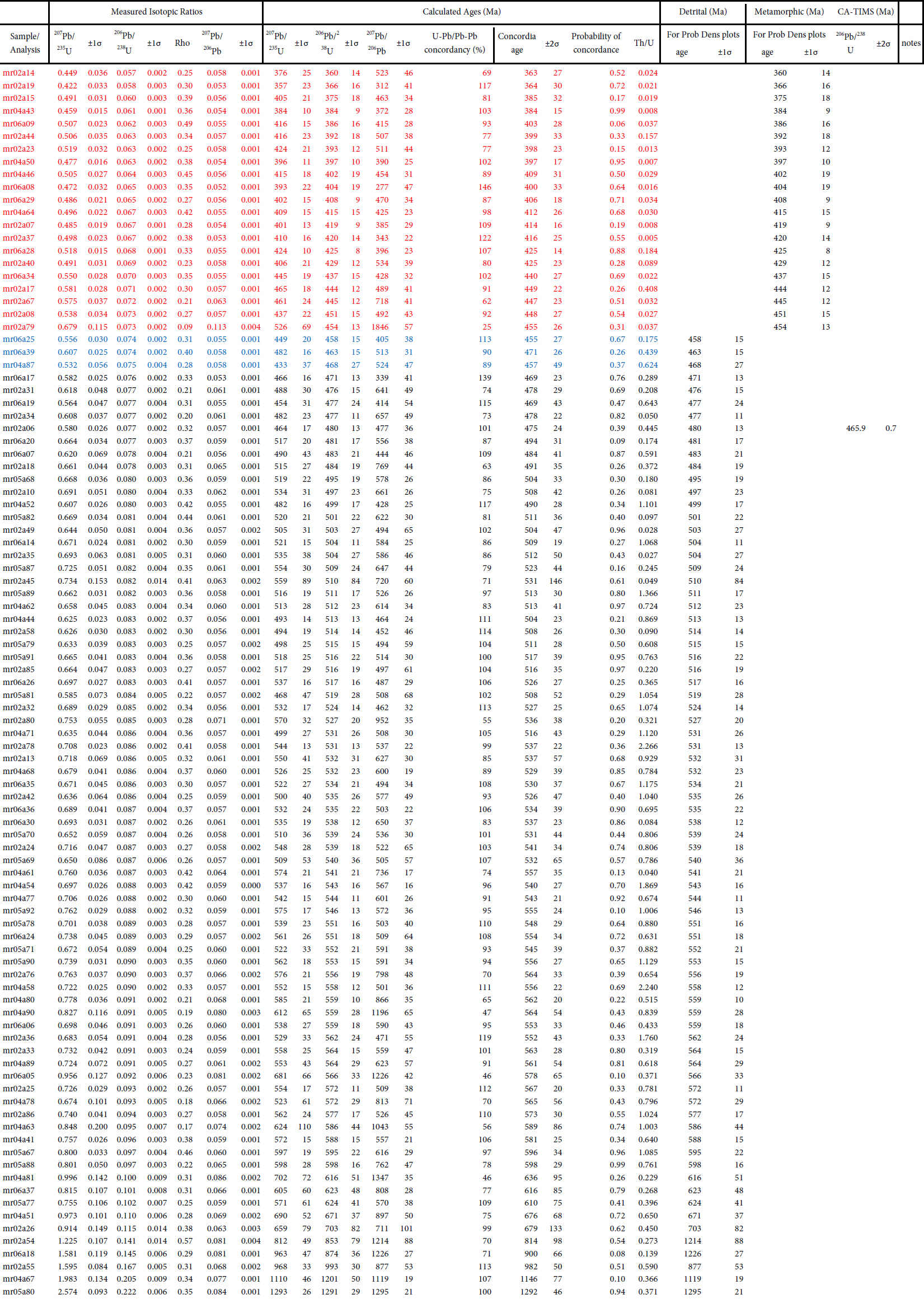 Display large image of Table A2
Display large image of Table A2
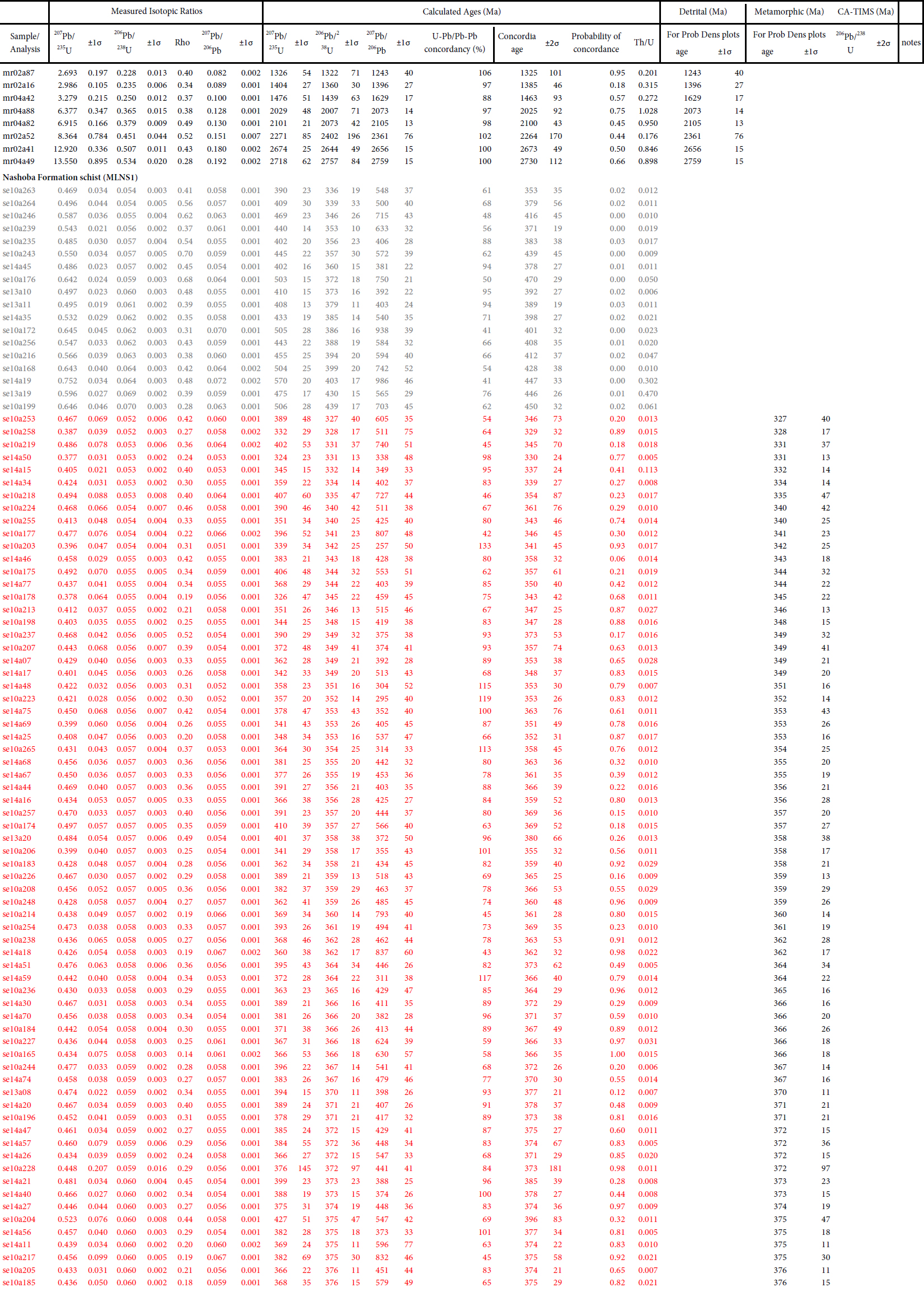 Display large image of Table A2
Display large image of Table A2
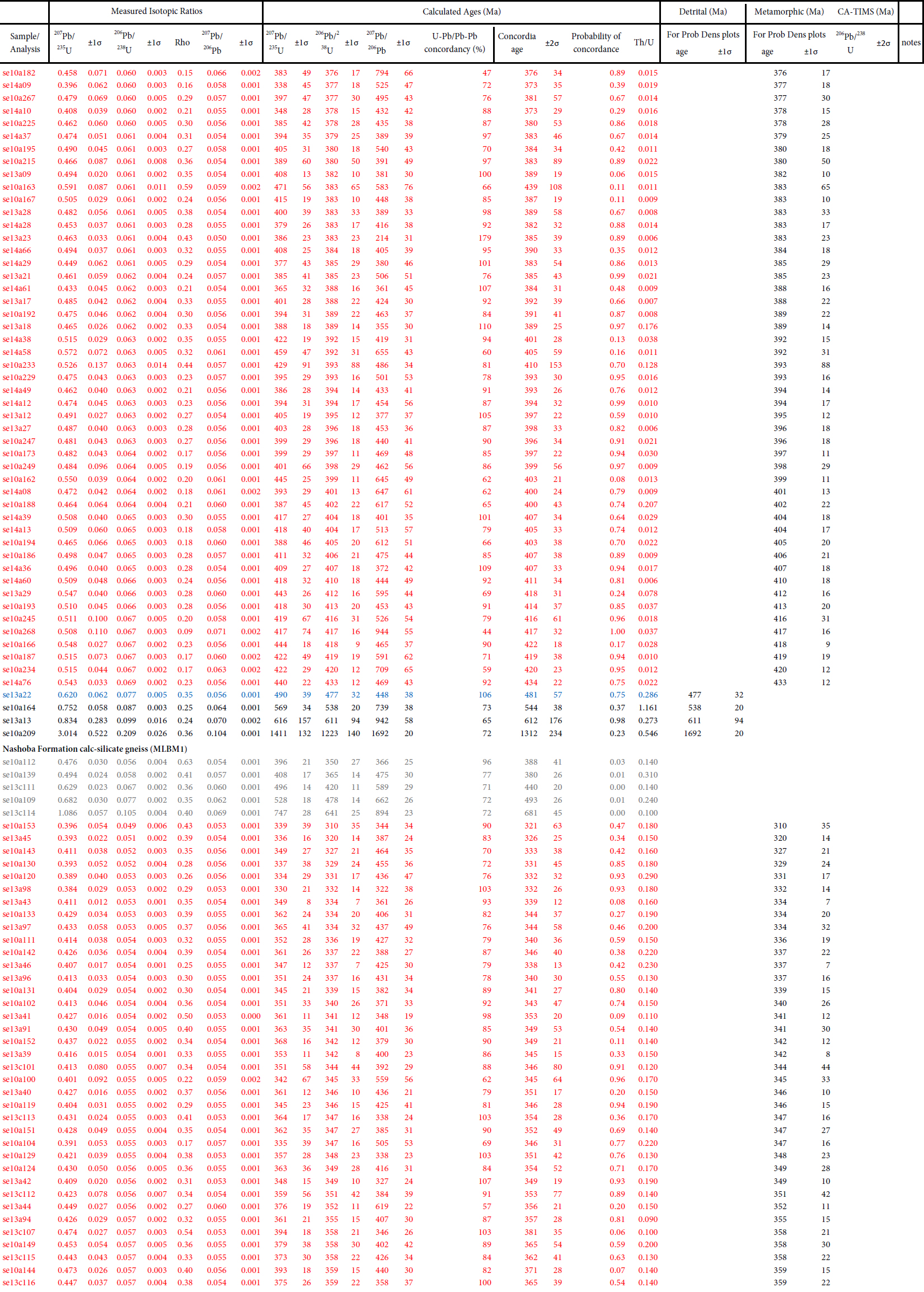 Display large image of Table A2
Display large image of Table A2
 Display large image of Table A2
Display large image of Table A2
 Display large image of Table A2
Display large image of Table A2
 Display large image of Table A2
Display large image of Table A2
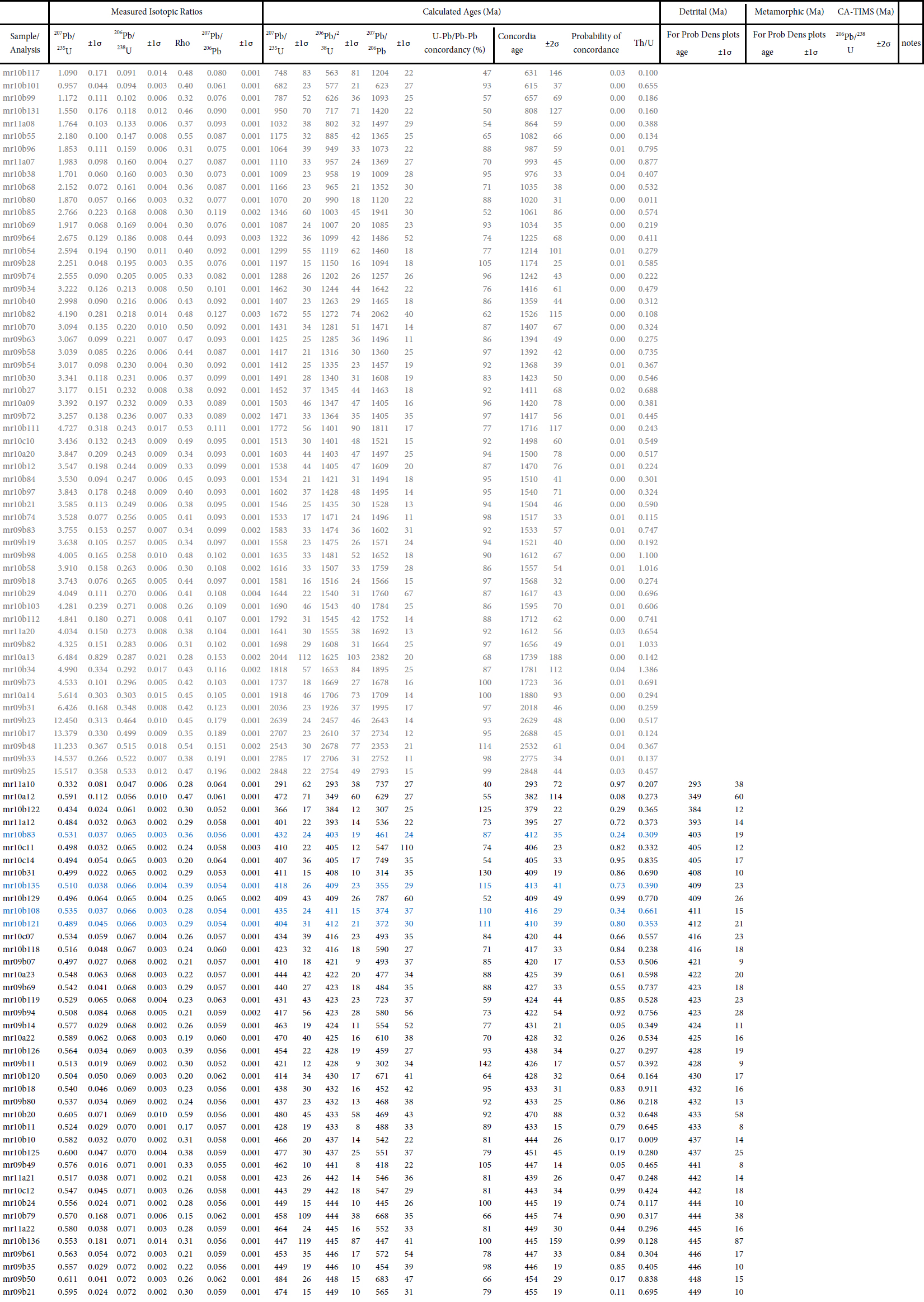 Display large image of Table A2
Display large image of Table A2
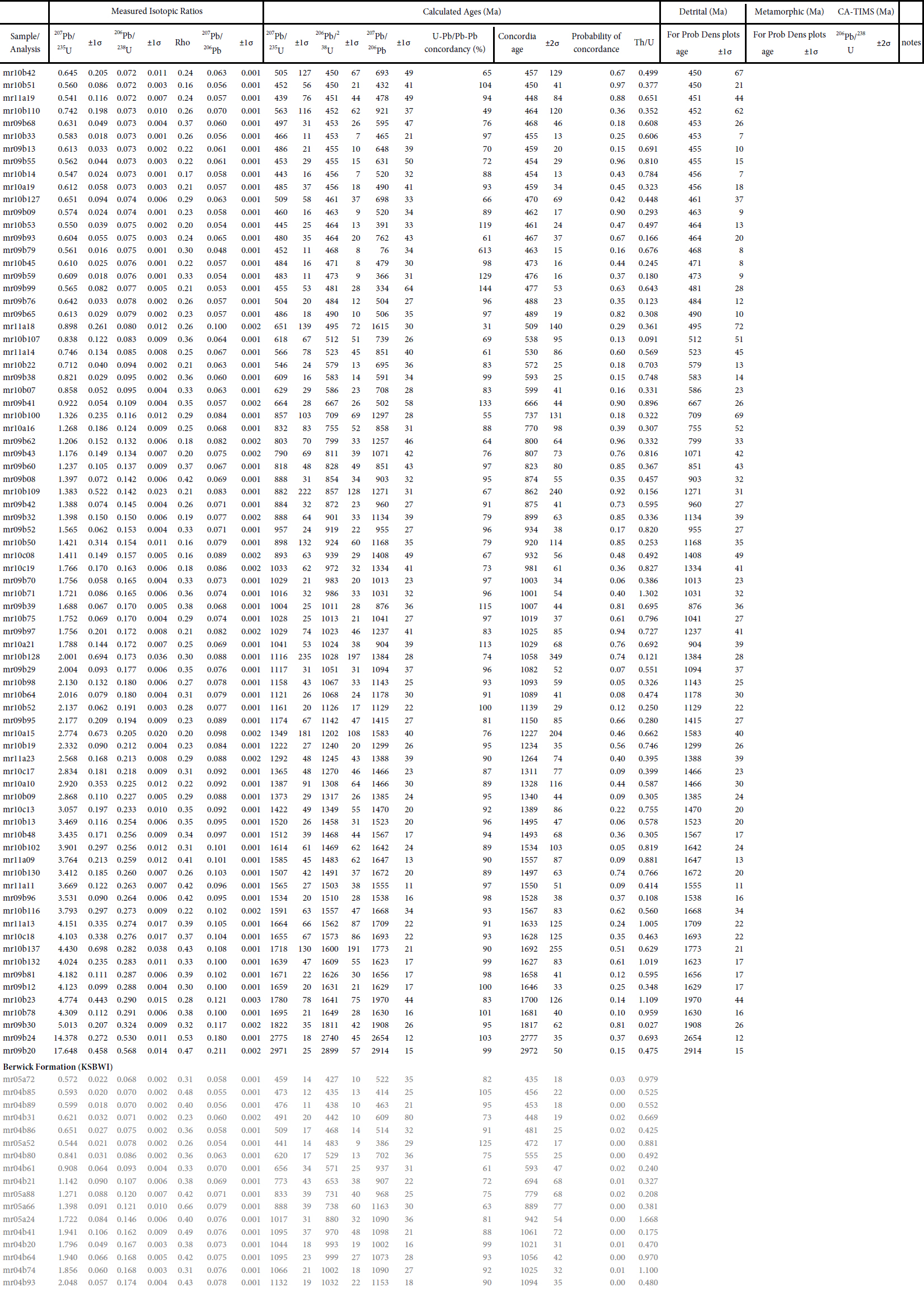 Display large image of Table A2
Display large image of Table A2
 Display large image of Table A2
Display large image of Table A2
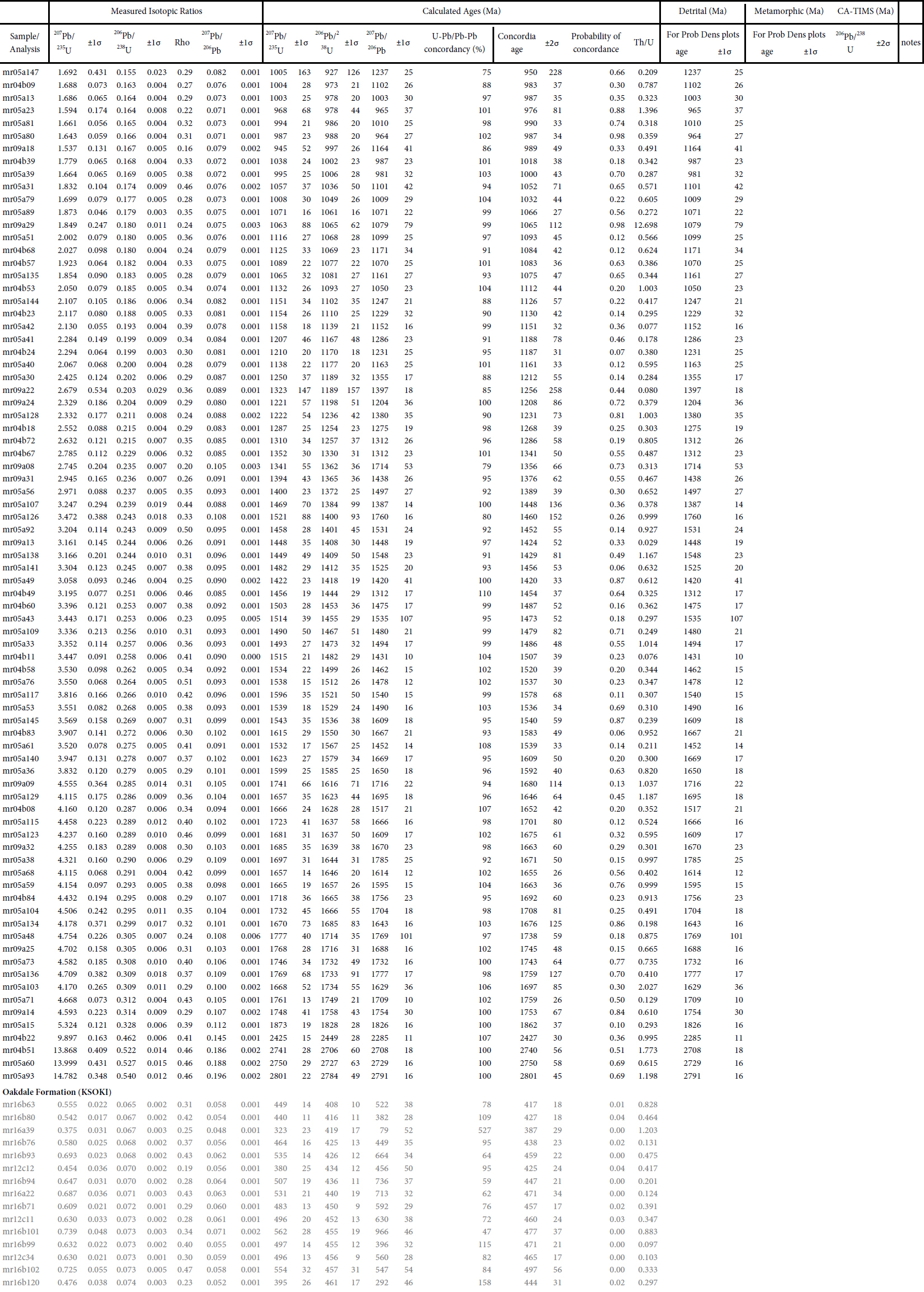 Display large image of Table A2
Display large image of Table A2
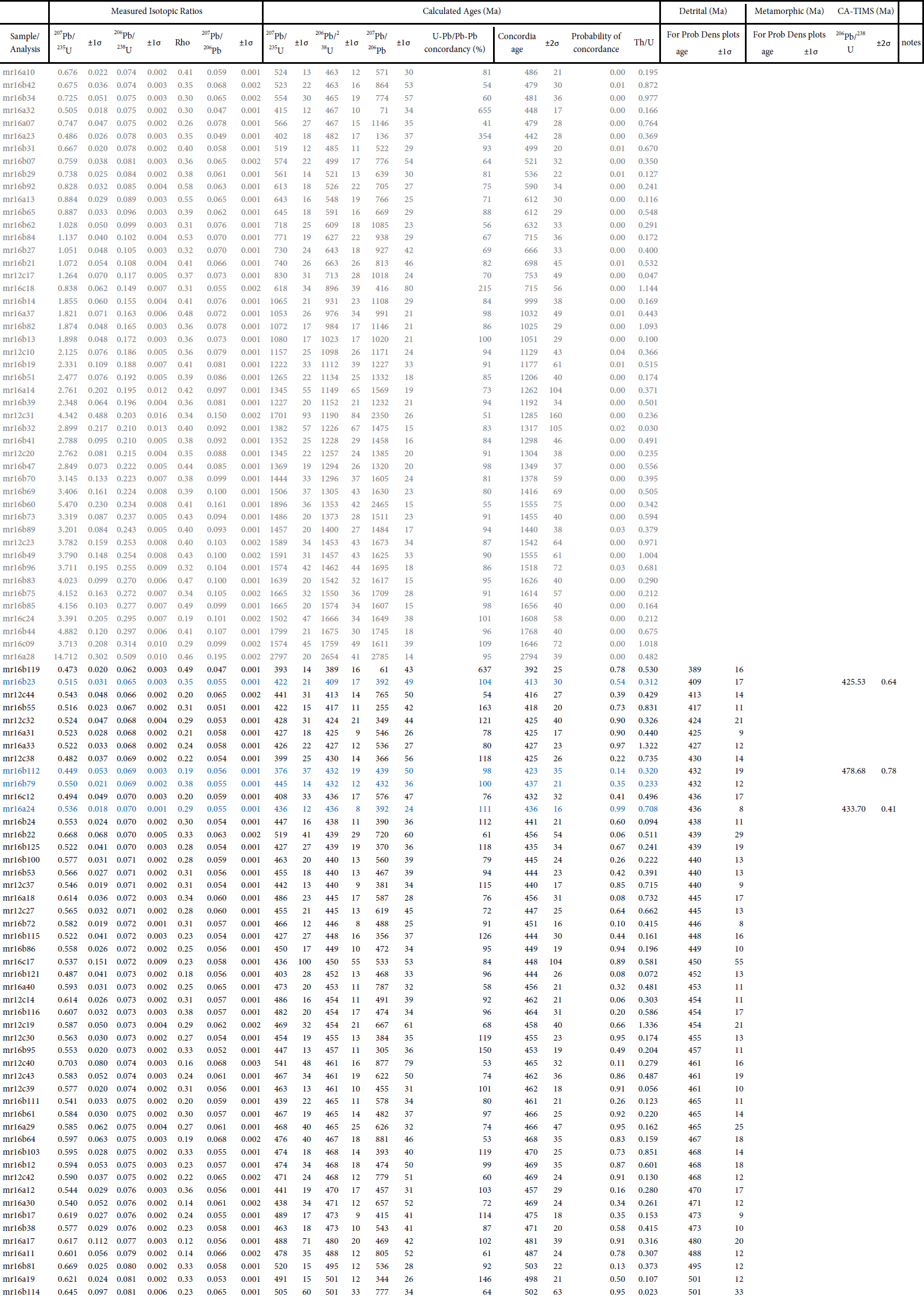 Display large image of Table A2
Display large image of Table A2
 Display large image of Table A2
Display large image of Table A2
 Display large image of Table A2
Display large image of Table A2
 Display large image of Table A2
Display large image of Table A2
 Display large image of Table A2
Display large image of Table A2
 Display large image of Table A2
Display large image of Table A2
 Display large image of Table A2
Display large image of Table A2
 Display large image of Table A2
Display large image of Table A2
Footnotes
- Data in grey - probability of concordance <0.05
- Data in red - interpreted as metamorphic, based on morphology and generally low Th/U
- Data in blue - youngest detrital zircon age population
- Data in black - all other detrtital zircon data
Notes
- abundant cracks and an amorphous shaped core; included in metamorphic population despite high Th/U
- relatively low probability of concordance
- older age but low Th/U
- excluded from weighted average in text and figure; reversely discordant outlier
